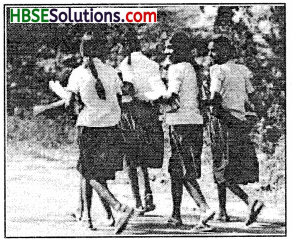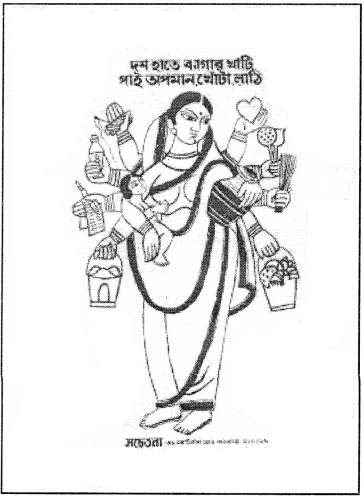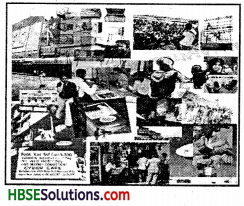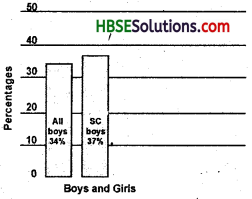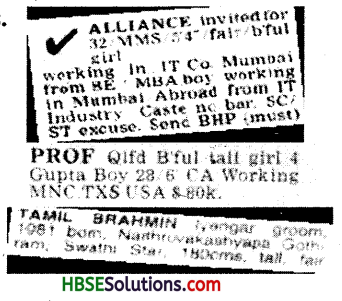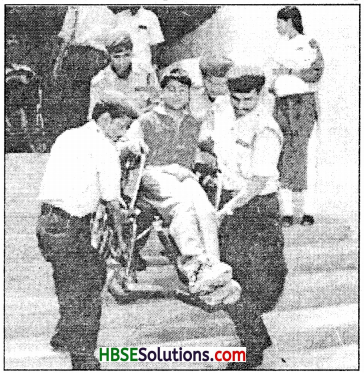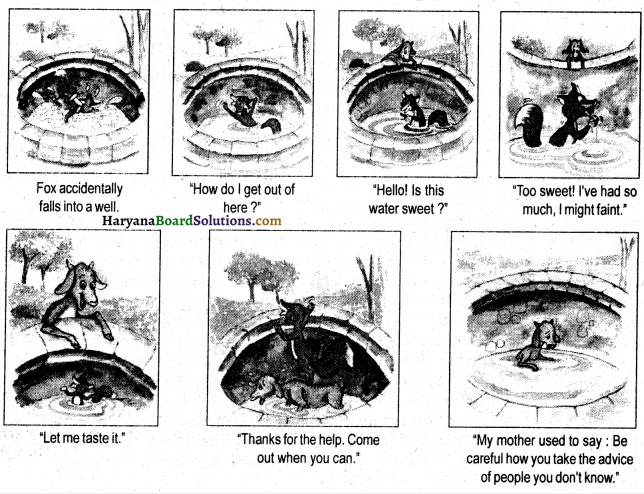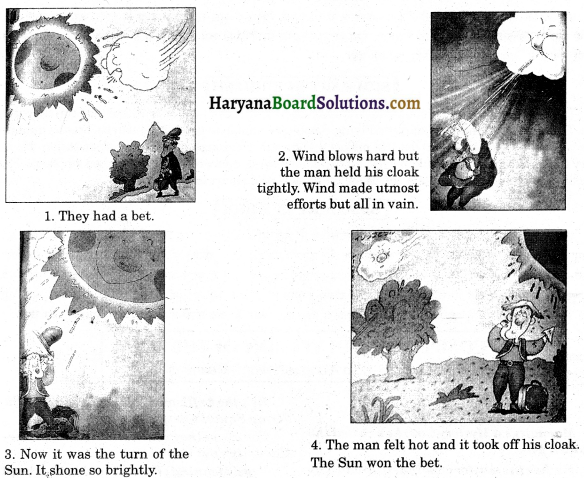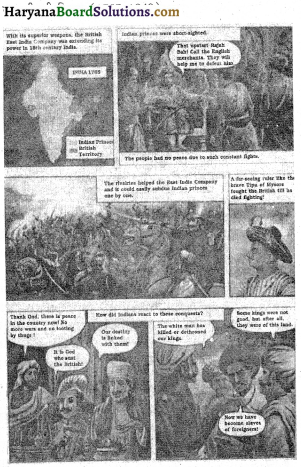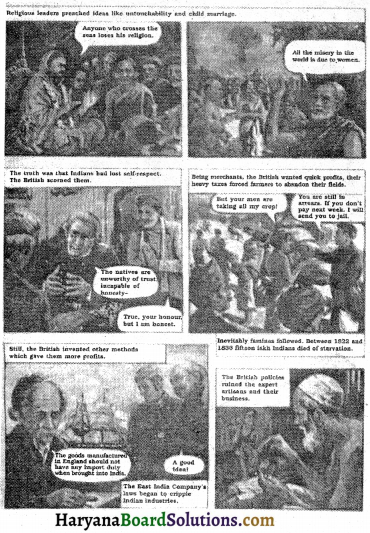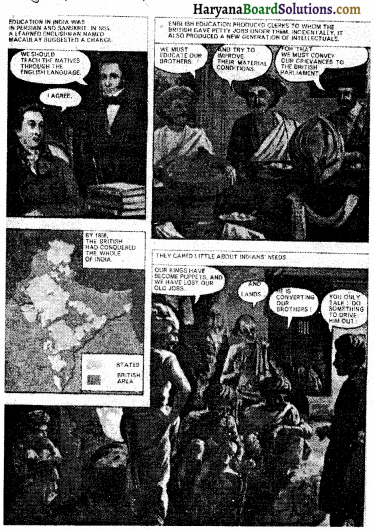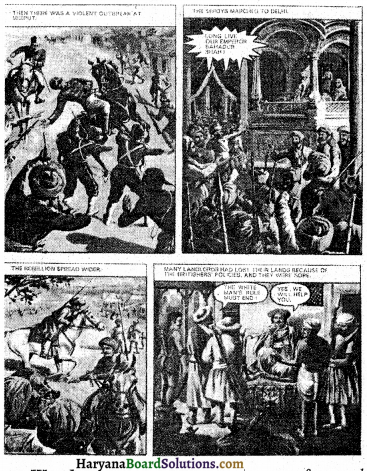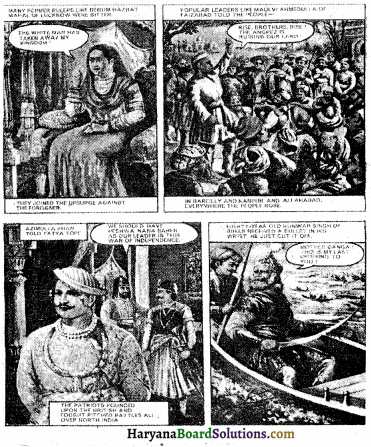Haryana State Board HBSE 9th Class Science Important Questions Chapter 15 खाद्य संसाधनों में सुधार Important Questions and Answers.
Haryana Board 9th Class Science Important Questions Chapter 15 खाद्य संसाधनों में सुधार
अति लघूत्तरात्मक प्रश्न
प्रश्न 1.
भोजन के प्रमुख अवयव कौन-कौन से हैं?
उत्तर:
प्रोटीन, वसा, विटामिन, खनिज लवण, कार्बोहाइड्रेटस आदि।
प्रश्न 2.
भोजन हमें कहाँ से मिलता है?
उत्तर:
पौधों और जंतुओं से।
प्रश्न 3.
फसल उत्पादन में वृद्धि कैसे संभव हुई है?
उत्तर:
हरित क्रांति के द्वारा।
प्रश्न 4.
श्वेत क्रांति से क्या भाव है?
उत्तर:
दूध का अधिक उत्पादन श्वेत क्रांति कहलाता है।

प्रश्न 5.
कृषि व पशुपालन में किस प्रणाली को अपनाने की आवश्यकता है?
उत्तर:
संपूषणीय प्रणाली।
प्रश्न 6.
कार्बोहाइड्रेटस के प्रमुख स्रोत लिखो।
उत्तर:
गेहूँ, चावल, मक्का, ज्वार व बाजरा।
प्रश्न 7.
प्रोटीन किन पादप उत्पादों से प्राप्त होती है?
उत्तर:
चना, मटर, उड़द, मूंग, अरहर व मसूर से।
प्रश्न 8.
वसा के स्रोतों के नाम लिखो।
उत्तर:
सोयाबीन, मूंगफली, तिल, अरंड, सरसों, अलसी व सूरजमुखी।
प्रश्न 9.
विटामिन व लवण किनसे मिलते हैं?
उत्तर:
सब्जी, मसाले व फल से।
प्रश्न 10.
चारा देने वाली फसलों के नाम लिखो।
उत्तर:
बरसीम, जई, सूडान घास, मक्का व ज्वार।
प्रश्न 11.
पौधों में पुष्पन और वृद्धि किस कारक पर निर्भर करते हैं?
उत्तर:
दीप्तिकाल पर (सूर्य प्रकाश काल)।
प्रश्न 12.
वर्षा ऋतु में कौन-सी फसलें उगाई जाती हैं?
उत्तर:
खरीफ फसलें।
प्रश्न 13.
रबी की फसलें कब उगाई जाती हैं?
उत्तर:
शीत ऋतु में।
प्रश्न 14.
किन्हीं चार खरीफ फसलों के नाम लिखो।
उत्तर:
मक्का, कपास, मूंग, उड़द, धान व सोयाबीन।
प्रश्न 15.
रबी की फसलें कौन-कौन सी हैं?
उत्तर:
चना, मटर, सरसों व अलसी।
प्रश्न 16.
फसलों का संकरण किसे कहते हैं?
उत्तर:
फसलों में ऐच्छिक गुण विकसित करने के लिए, विभिन्न आनुवंशिक गुणों वाले पौधों का संकरण (क्रॉस) करवाया जाता है, इसे ही फसलों का संकरण कहते हैं।
प्रश्न 17.
फसल सुधार की नई विधि कौन-सी है?
उत्तर:
ऐच्छिक गुणों वाली जीन को फसलों में डालकर उच्च उपजी नसलें तैयार की जाती हैं।
प्रश्न 18.
उच्च उत्पादन किसे कहते हैं?
उत्तर:
प्रति एकड़ फसल का उत्पादन बढ़ाना, उच्च उत्पादन कहलाता है।
प्रश्न 19.
जैविक प्रतिरोधिता किसे कहते हैं?
उत्तर:
रोग, कीट आदि से प्रतिरोधिता जैविक प्रतिरोधिता कहलाती है।
प्रश्न 20.
अजैविक प्रतिरोधिता की परिस्थितियों के नाम लिखो।
उत्तर:
सूखा, क्षारता, जलाक्रांति, गर्मी, ठंड और पाला आदि।
प्रश्न 21.
फसलों के परिपक्वन काल में कमी करना लाभदायक है या हानिकारक?
उत्तर:
लाभदायक।
प्रश्न 22.
अनाज के लिए बौने पौधे उगाना उपयुक्त क्यों है?
उत्तर:
क्योंकि बौने पौधों को कम पोषकों की आवश्यकता होती है।
प्रश्न 23.
हमें भोजन की आवश्यकता क्यों होती है?
उत्तर:
विकास, वृद्धि और स्वस्थ रहने के लिए।
प्रश्न 24.
पौधों को पोषक पदार्थ कहाँ से मिलते हैं?
उत्तर:
हवा, पानी और मिट्टी से।
प्रश्न 25.
वृहत् पोषकों की संख्या कितनी है?
उत्तर:
6 (नाइट्रोजन, फॉस्फोरस, पोटैशियम, कैल्शियम, मैग्नीशियम और सल्फर)।

प्रश्न 26.
सूक्ष्म पोषकों की संख्या कितनी है?
उत्तर:
7 (आयरन, मैंगनीज, बोरॉन, जिंक, कॉपर, मॉलिब्डेनम् और क्लोरीन)।
प्रश्न 27.
खाद कैसे तैयार की जाती है?
उत्तर:
सूक्ष्मजीवों के द्वारा जंतुओं के अवशिष्ट व पौधों के कचरे से खाद तैयार की जाती है।
प्रश्न 28.
हरी खाद के लिए मुख्य रूप से कौन-सी फसलें उगाई जाती हैं?
उत्तर:
मूंग, पटसन।
प्रश्न 29.
उर्वरक किसे कहते हैं?
उत्तर:
कृत्रिम विधि द्वारा तैयार पौधों के लिए पोषक पदार्थों को उर्वरक कहते हैं।
प्रश्न 30.
क्या उर्वरक जैविक खाद से सस्ते हैं?
उत्तर:
नहीं, महंगे हैं।
प्रश्न 31.
उर्वरकों का एक दोष लिखो।
उत्तर:
इनसे जल प्रदूषण होता है।
प्रश्न 32.
भारत में सिंचाई का प्रमुख साधन क्या है?
उत्तर:
वर्षा।
प्रश्न 33.
वर्षा आधारित फसलों को सबसे अधिक नुकसान किससे होता है?
उत्तर:
सूखे से।
प्रश्न 34.
भूमिगत जल कैसे प्राप्त किया जाता है?
उत्तर:
कुएँ (टयूबवैल) खोदकर।
प्रश्न 35.
पानी की उपलब्धता बढ़ाने का एक आधुनिक उपाय लिखो।
उत्तर:
छोटे चेक डैम बनाकर।
प्रश्न 36.
मिश्रित फसल किसे कहते हैं?
उत्तर:
दो या दो से अधिक फसलें एक साथ एक ही खेत में उगाने को मिश्रित फसल कहते हैं।
प्रश्न 37.
मिश्रित फसल का एक उदाहरण लिखो।
उत्तर:
गेहूँ + चना, मूंगफली + सरजमुखी।
प्रश्न 38.
अंतराफसलीकरण किसे कहते हैं?
उत्तर:
दो या दो से अधिक फसलें एक साथ एक खेत में विशेष ढंग के साथ उगाने को अंतराफसलीकरण कहते हैं।
प्रश्न 39.
अंतराफसलीकरण का एक उदाहरण लिखो।
उत्तर:
सोयाबीन + मक्का (एक पंक्ति सोयाबीन + एक पंक्ति मक्का)।
प्रश्न 40.
फसल-चक्र किसे कहते हैं?
उत्तर:
किसी खेत में क्रमवार पूर्व नियोजित कार्यक्रम के अनुसार विभिन्न फसलों के उगाने को फसल-चक्र कहते हैं।
प्रश्न 41.
किन्हीं चार खरपतवारों के नाम लिखो।
उत्तर:
गोखरू, गाजर, घास, बथुआ व मेथी।
प्रश्न 42.
पीड़क किसे कहते हैं?
उत्तर:
फसल को नुकसान पहुंचाने वाले जंतुओं को पीड़क कहते हैं।
प्रश्न 43.
खरपतवारों को नष्ट करने वाले पदार्थों को क्या कहते हैं?
उत्तर:
शाकनाशी।
प्रश्न 44.
अनाज को क्षति पहुंचाने वाले जैविक कारकों के नाम लिखो।
उत्तर:
कीट, कृंतक, कवक व जीवाणु।
प्रश्न 45.
अन्न को खराब करने वाले अजैव कारकों के नाम लिखो।
उत्तर:
उपयुक्त ताप व नमी का अभाव।
प्रश्न 46.
पशुपालन किसे कहते हैं?
उत्तर:
पशुधन के प्रबंधन को पशुपालन कहते हैं।
प्रश्न 47.
ड्राफ्ट पशु किन्हें कहते हैं?
उत्तर:
बोझा ढोने वाले पशुओं को ड्राफ्ट पशु कहते हैं।
प्रश्न 48.
गाय की दो विदेशी नस्लों के नाम लिखो।
उत्तर:
गाय की दो विदेशी नस्लें जर्सी व ब्राउन स्विस हैं।
प्रश्न 49.
गाय की दो देशी नस्लों के नाम लिखो।
उत्तर:
गाय की दो देशी नस्ले साहीवाल व रेडसिंधी हैं।
प्रश्न 50.
डेयरी पश किसे कहते हैं?
उत्तर:
दूध देने वाले पशुओं को डेयरी पशु कहते हैं।
प्रश्न 51.
पशुओं के दो बाह्य परजीवी लिखो।
उत्तर:
चिंचड़ी व जूं।
प्रश्न 52.
पशुओं में यकृत को कौन-से परजीवी प्रभावित करते हैं?
उत्तर:
पर्ण कृमि (फ्यूक वग)।
प्रश्न 53.
कुक्कुट पालन किसे कहते हैं?
उत्तर:
मुर्गी, बत्तख, हंस और टर्की के पालन को कुक्कुट पालन कहते हैं।
प्रश्न 54.
लेअर किसे कहते हैं?
उत्तर:
अंडे देने वाली मुर्गी को लेअर कहते हैं।
प्रश्न 55.
ब्रौलर किसे कहते हैं?
उत्तर:
केवल मांस के लिए पाली जाने वाली मुर्गी ब्रौलर कहलाती है।
प्रश्न 56.
मत्स्य पालन किसे कहते हैं?
उत्तर:
मछलियों, प्रॉन और मोलस्कों को आर्थिक महत्त्व के लिए पालना, मत्स्य पालन कहलाता है।
प्रश्न 57.
किन्हीं तीन लवणीय मछलियों के उदाहरण दो।
उत्तर:
कैट फिश, सारडाइन और शार्क।
प्रश्न 58.
किन्हीं चार अलवणीय मछलियों के नाम लिखो।
उत्तर:
कटला, रोहु, मुलेट व मिलिटस।
प्रश्न 59.
मिश्रित मछली संवर्धन में कौन-कौन सी मछलियाँ पाली जाती हैं?
उत्तर:
कटला, रोहु, मृगल आदि।
प्रश्न 60.
मिश्रित संवर्धन की सबसे बड़ी समस्या क्या है?
उत्तर:
अच्छी गुणवत्ता वाले डिम्भों का न मिलना।
प्रश्न 61.
मधुमक्खी पालन किसे कहते हैं?
उत्तर:
शहद और मोम के लिए मधुमक्खियों को पालना मधुमक्खी पालन कहलाता है।
प्रश्न 62.
भारतीय मधुमक्खी की नस्ल का नाम लिखो।
उत्तर:
ऐपिस सेरना इंडिका।
प्रश्न 63.
मधुमक्खी की दो किस्मों के नाम लिखो।
उत्तर:
ऐपिस डोरसेटा, ऐपिस फ्लोरी।
प्रश्न 64.
इटेलियन मधुमक्खी का नाम लिखो।
उत्तर:
ऐपिस मेलीफेरा।
प्रश्न 65.
मछलियों से क्या प्राप्त होता है?
उत्तर:
मछलियों से तेल; जैसे कॉड तथा शार्कलिवर तेल प्राप्त होते हैं जो विटामिन A तथा D के अच्छे स्रोत हैं।
लघूत्तरात्मक प्रश्न
प्रश्न 1.
भोजन के क्या कार्य हैं?
उत्तर:
हर जीवधारी को जीवित रहने के लिए भोजन की आवश्यकता होती है। भोजन के कार्य निम्नलिखित प्रकार से हैं-
- भोजन से हमें ऊर्जा मिलती है।
- भोजन क्षतिग्रस्त कोशिकाओं, ऊतकों और अंगों की मुरम्मत और पुनर्निर्माण में सहायक है।
- भोजन शारीरिक वृद्धि और प्रजनन में सहायक है।
- भोजन रोगों के प्रति प्रतिरक्षात्मक शक्ति पैदा करके हमें उनसे बचाता है।
प्रश्न 2.
हमारे भोजन के विभिन्न स्रोतों के नाम बताएँ।
उत्तर:
हमारे भोजन के स्रोत निम्नलिखित हैं-
- पौधे हमारे भोजन का मुख्य भाग; जैसे अन्न, दालें, गर्म मसाले, तेल देने वाले बीज, फल, सब्जियाँ, शर्करा आदि पौधों से ही प्राप्त होते हैं। पौधे स्वपोषी होते हैं, साथ ही जंतुओं के लिए भोजन तैयार करते हैं।
- जंतु-जंतु अपने भोजन के लिए मुख्य पौधों पर निर्भर होते हैं, परंतु यही जंतु अन्य जंतुओं के लिए खाद्य पदार्थ जैसे दूध, मांस, अंडे, मक्खन, घी आदि प्रदान करते हैं।
प्रश्न 3.
भोजन के प्रमुख अवयवों व उनके स्रोतों के नाम लिखो।
उत्तर:
भोजन के अवयव और इनके स्रोत निम्नलिखित हैं-
| क्रमांक | अवयव का नाम | स्रोत |
| 1. | कार्बोहाइड्रेटस | गेहूँ मक्का, बाजरा, चावल, ज्वार व आलू आदि। |
| 2. | प्रोटीन | दालें मसूर, उड़द, चना, अरहर व मूँग आदि। |
| 3. | वसा | सोयाबीन, मूँगफली, तिल, अरंड, सरसों, अलसी व सूरजमुखी आदि। |
| 4. | विटामिन व खनिज लवण | फल, सब्जियाँ व मसाले। |
प्रश्न 4.
हरित क्रांति से क्या तात्पर्य है?
उत्तर:
कृषि पैदावार को तेजी से बढ़ाने को हरित क्रांति कहते हैं। हरित क्रांति उन्नत किस्म के बीज, पीड़कनाशी, खरपतवारनाशी, उर्वरक, सिंचाई की आधुनिक विधियाँ तथा आधुनिक कृषि-यंत्रों के उपयोग से संभव हुई है। कृषि की आधुनिकतम तकनीक सघन कृषि पद्धति के द्वारा किसानों तक पहुँची है जो वैज्ञानिक अनुसंधानों पर आधारित है। परिणामस्वरूप कृषि के क्षेत्र में एक अभूतपूर्व परिवर्तन हुआ है, जिसे हरित क्रांति के नाम से जाना जाता है।

प्रश्न 5.
फसलों की किस्मों के सुधार की क्या आवश्यकता है?
उत्तर:
फसलों की किस्मों के सुधार की आवश्यकता निम्नलिखित उद्देश्यों की पूर्ति हेतु होती है-
- अधिक उपज बढ़ाने के लिए।
- उत्तम गुणवत्ता के लिए।
- फसलों में रोग प्रतिरोधी क्षमता पैदा करने के लिए।
- समान परिपक्वता के लिए।
- प्रकाश एवं ताप के प्रति असंवेदनशीलता बढ़ाने के लिए।
- कृषि में ऐच्छिक गुणों के विकास के लिए।
- फसलों में व्यापक अनुकूलता पैदा करने के लिए।
प्रश्न 6.
विभिन्न फसलों के लिए आवश्यक प्रमुख जलवायुवीय परिस्थितियाँ कौन-सी हैं?
उत्तर:
फसलों को उचित वृद्धि और विकास के लिए जल, मिट्टी, वायु और ताप की आवश्यकता होती है, परंतु इनमें सबसे प्रमुख दो परिस्थितियाँ ऐसी हैं जिनके द्वारा फसलों की वृद्धि, फसलों का पकना व जीवन-चक्र पूरा करना आदि जुड़े हैं। ये परिस्थितियाँ हैं तापमान और दीप्तिकाल। तापमान फसलों के पकने व दीप्तिकाल पुष्पन और वृद्धि से जुड़ा है। पौधे दीप्तिकाल (सूर्य के प्रकाश) के द्वारा ही प्रकाशसंश्लेषण कर अपना भोजन बनाते हैं।
प्रश्न 7.
खरीफ और रबी की फसलों के बारे में आप क्या जानते हैं?
उत्तर:
ऋतु के आधार पर फसलें निम्नलिखित दो प्रकार की होती हैं:
- खरीफ की फसलें।
- रबी की फसलें।
1. खरीफ की फसलें ये फसलें गर्मियों, विशेषकर जून व जुलाई में बोई जाती हैं। इन फसलों को उगाने के लिए अधिक गर्मी व अधिक पानी की आवश्यकता पड़ती है। सर्दी के शुरू में ही इन्हें काट लिया जाता है।
उदाहरण मक्का, धान, ज्वार, बाजरा, उड़द, मूंग, तिल, घीया, पेठा, टिंडा, भिंडी आदि।
2. रबी की फसलें ये फसलें सर्दियों में बोई जाती हैं। इन फसलों को उगाने के लिए कम ताप व कम पानी की आवश्यकता होती है। इन्हें गर्मियों के आरंभ में काट लिया जाता है।
उदाहरण-गेहूँ, जौ, मटर, चना, सरसों, गाजर, मूली, शलगम, गोभी, बरसीम आदि।
प्रश्न 8.
पौधों की किस्मों को कैसे सुधारा जा सकता है?
उत्तर:
पौधों की किस्मों को निम्नलिखित विधियों द्वारा सुधारा जा सकता है-
1. उचित बीजों का चुनाव बोने के लिए हमें ऐसे बीजों का चुनाव करना चाहिए जो अधिक उत्पादक तथा बीमारियों, पीड़कों और परजीवियों के प्रतिरोधी हों। लगातार ऐसा करने से पौधों की नस्ल सुधर जाती है।
2. अच्छी किस्म के आयातित पौधे लगाना यदि स्थानीय किस्में कम उत्पादक हों और उन्हें सुधारा न जा सकता हो तो हमें दूसरे देश से अच्छी नस्ल के अधिक उत्पादक पौधे मंगवाने चाहिएँ; जैसे तुई चुग नेटिव-I चावल तथा सोनारा-64 गेहूँ विदेशों से मंगवाए गए हैं।
3. संकरण संकरण विधि में विभिन्न आनुवंशिक गुणों वाले पौधों में संकरण करवाते हैं। इसमें जो संकर प्राप्त होता है उसमें दोनों किस्मों के उपयोगी गुण विद्यमान होते हैं। फलों और सब्जियों की बहुत-सी अच्छी किस्में इसी विधि से तैयार की गई हैं। G-57 तथा G-67 इसी विधि से तैयार की गई कपास की उन्नत किस्में हैं।
4. उत्प्रेरित उत्परिवर्तनजनी यह वह विधि है जिसमें उच्च तापमान, विशेष विकिरण या रासायनिक पदार्थों द्वारा पौधों के जीन में ऐसे उत्प्रेरित परिवर्तन लाए जाते हैं कि उत्पन्न होने वाले जीनों में इच्छित गुण आ जाएँ।
प्रश्न 9.
कृषि प्रणालियों को मुख्य रूप से कितने चरणों में बाँटा जा सकता है?
उत्तर:
कृषि प्रणालियों को मुख्य रूप से तीन चरणों में बांटा जा सकता है-
- बीजों का चुनना।
- फसल की देखभाल।
- खेतों में उगी फसल की सुरक्षा तथा कटी हुई फसल को हानि से बचाना।
प्रश्न 10.
उच्च उत्पादन के लिए उन्नत किस्मों का क्या योगदान है?
उत्तर:
प्रति एकड़ फसल उत्पादन को बढ़ाना उच्च उत्पादन कहलाता है। फसलों की उच्च उत्पादन किस्मों का अर्थ है-
- ये रोग प्रतिरोधी हों।
- जलवायु, भूमि और उर्वरकों के अनुरूप हों।
- उच्च उत्पादन क्षमता वाले हों।
- संरक्षण की अधिक गुणवत्ता वाले हों। उपरोक्त मापदंडों पर आधारित किस्मों को उन्नत किस्मों की संज्ञा दी जा सकती है।
प्रश्न 11.
फसलों का परिपक्वन काल कम होने के क्या लाभ हैं?
उत्तर:
फसलों को उगाने से लेकर कटाई या उत्पादन प्राप्त करने का काल, परिपक्वन काल कहलाता है। परिपक्वन काल आर्थिक दृष्टि से अच्छा है, क्योंकि कम समय होने के कारण फसल उत्पादन खर्च में कमी आ जाती है और किसान का समय व मेहनत दोनों की बचत होती है तथा फसल उत्पादन शीघ्र मिल जाता है।
प्रश्न 12.
व्यापक अनुकूलता वाली किस्मों का विकास करना किस प्रकार लाभप्रद है?
उत्तर:
हमारे देश में विभिन्न पर्यावरणीय परिस्थितियाँ पाई जाती हैं अर्थात् किसी भाग में गर्मी और किसी भाग में सर्द जलवायु पाई जाती है। तटीय क्षेत्रों में सम जलवायु पाई जाती है। अतः इन विभिन्न जलवायु वाले क्षेत्रों में भिन्न-भिन्न किस्मों की फसलें उगाई जा सकती हैं।
अतः अब प्रयास किए जा रहे हैं कि व्यापक अनुकूलता वाली किस्मों का विकास किया जाए ताकि व्यापक क्षेत्रों में एक ही प्रकार की फसल उगाई जा सके। ऐसा करने से फसल उत्पादन को स्थायी करने में सहायता मिलेगी। एक ही किस्म की फसलों को विभिन्न क्षेत्रों व विभिन्न जलवायु में उगाना संभव हो जाएगा।
प्रश्न 13.
हरे पौधों की वृद्धि तथा विकास के लिए आवश्यक पोषक तत्त्वों के विषय में आप क्या जानते हैं?
उत्तर:
हरे पौधों की सामान्य वृद्धि तथा विकास के लिए कम-से-कम 16 तत्त्वों की आवश्यकता होती है, जिन्हें पोषक तत्त्व कहते हैं। पोषक तत्त्व पौधों की आवश्यकता की मात्रा के आधार पर दो प्रकार के होते हैं-
1. वृहत् पोषक तत्त्व-ऐसे पोषक तत्त्व जिनकी आवश्यकता पौधों को अधिक मात्रा में होती है, वृहत पोषक तत्त्व कहलाते हैं; जैसे नाइट्रोजन, पोटैशियम, कैल्शियम, मैगनीशियम, फॉस्फोरस तथा सल्फर। इनकी संख्या 6 है।
2. सूक्ष्म पोषक तत्त्व-वे पोषक तत्त्व जिनकी आवश्यकता पौधों को सूक्ष्म मात्रा में होती है, सूक्ष्म पोषक तत्त्व कहलाते हैं; जैसे लोहा, मैंगनीज, जिंक, तांबा, बोरॉन, मॉलिब्डेनम्, क्लोरीन आदि। इनकी संख्या 7 है। पौधे हवा से कार्बन और ऑक्सीजन तथा पानी से हाइड्रोजन व ऑक्सीजन भी पोषकों के रूप में ग्रहण करते हैं। उपरोक्त 13 पोषकों को पौधे मिट्टी से ग्रहण करते हैं।
प्रश्न 14.
खादें किसे कहते हैं? खादें मुख्य रूप से कितने प्रकार की होती हैं?
उत्तर:
भूमि की उपजाऊ शक्ति को निरंतर बनाए रखने के लिए इसमें कुछ विशेष पदार्थों को मिलाना पड़ता है। ये विशेष पदार्थ, जो भूमि की उपजाऊ शक्ति को बनाए रखते हैं, खाद कहलाते हैं। खादें मुख्य रूप से निम्नलिखित दो प्रकार की होती हैं-
1. जैविक खादें-ये खादें जीव-जंतुओं के अवशेषों, उनके अपशिष्ट पदार्थों तथा अन्य कूड़े-करकट से तैयार की जाती हैं। जैविक खादों में हरी खाद, कंपोस्ट खाद व गोबर की खाद प्रमुख हैं।
2. अजैविक खादें-ये खादें कृत्रिम रूप से तैयार की जाती हैं, उन्हें अजैविक खादें कहते हैं। ये मुख्य रूप से तीन प्रकार की होती हैं नाइट्रोजन, फास्फोरस और पोटैशियम वाली खादें। इन्हें रासायनिक उर्वरक भी कहते हैं।
प्रश्न 15.
उर्वरक और खाद किसे कहते हैं? उनके अंतर लिखो।
उत्तर:
उर्वरक-उर्वरक वे रासायनिक पदार्थ हैं जिनमें पौधों के लिए आवश्यक पोषक पाए जाते हैं। ये मुख्यतः अकार्बनिक यौगिक होते हैं।
खाद-यह एक प्राकृतिक पदार्थ होता है। इन्हें पादप व जंतुओं के अपशिष्टकों के अपघटन से बनाया जाता है। ये मुख्यतः कार्बनिक पदार्थ होते हैं।
उर्वरक और खाद में अंतर निम्नलिखित हैं-
| उर्वरक | खाद |
| 1. ये कृत्रिम पदार्थ हैं। | 1. ये प्राकृतिक पदार्थों से बनती हैं। |
| 2. इनमें पोषक तत्त्वों की प्रचुर मात्रा होती है। | 2. इनमें पोषक तत्त्वों की प्रचुर मात्रा नहीं होती। |
| 3. ये मिट्टी की बनावट में सहायक नहीं हैं। | 3. ये मिट्टी को बनाए रखती हैं। |
| 4. ये मुख्यतः अकार्बनिक पदार्थ हैं। | 4. ये मुख्यत: कार्बनिक पदार्थ हैं। |
| 5. ये कम स्थान घेरते हैं, इसलिए इनका भंडारण व स्थानांतरण सुविधाजनक है। | 5. ये बहुत अधिक स्थान घेरते हैं, इसलिए इनका भंडारण व स्थानांतरण सुविधाजनक नहीं है। |
| 6. इनकी कम मात्रा में आवश्यकता होती है। | 6. इनकी अधिक मात्रा में आवश्यकता होती है। |
| 7. उर्वरक रासायनिक विधियों द्वारा बनाए जाते हैं। | 7. खाद सूक्ष्मजीवों की सहायता से बनती है। |
| 8. यह तुरंत प्रभाव डालता है। | 8. खाद का प्रभाव धीरे-धीरे पड़ता है। |
| 9. उर्वरक मृदा प्रदूषण का कारण हैं। | 9. खाद भूमि प्रदूषण का कारण नहीं है। |
प्रश्न 16.
कंपोस्ट खाद से क्या तात्पर्य है?
उत्तर:
कंपोस्ट खाद वनस्पति उत्पादों, मृत जंतुओं तथा जंतु-अपशिष्ट से तैयार की जाती है। कंपोस्ट खाद बनाने के लिए एक गड्ढा खोदकर उसमें पादप और जंतु अपशिष्टों की एक परत बिछा दी जाती है। इस परत को मिट्टी की परत से ढक देते हैं ताकि अपशिष्ट हवा और प्रकाश से बचे रहें और इनमें नमी बनी रहे। मिट्टी के ऊपर घास-फूस या पत्तियों की तह बिछा दी जाती है। गड्ढे में उपस्थित सूक्ष्मजीव जैव अपशिष्टों का अपघटन कर, इन्हें उपयोगी खाद में परिवर्तित कर देते हैं। इसे कंपोस्ट खाद कहते हैं। केंचुए के उपयोग से बनाए कंपोस्ट को वर्मीकंपोस्ट कहते हैं।
प्रश्न 17.
हरी खाद किसे कहते हैं?
उत्तर:
फसलों को उगाने से पूर्व खेतों में सन, मूंग, ज्वार जैसी फसलों को उगाया जाता है जब ये 1/2-2 फुट की हो जाती हैं, उन्हें हल चलाकर भूमि में मिला दिया जाता है और खेत को पानी से भर देते हैं ताकि हरे पौधे गल-सड़कर खाद में परिवर्तित हो जाएँ। इसे हरी खाद कहते हैं जो मिट्टी में नाइट्रोजन तथा फास्फोरस की मात्रा को मिलाकर उर्वरा शक्ति को बढ़ाने में सहायता करते हैं।
प्रश्न 18.
उर्वरक एक आवश्यक बुराई है, कैसे?
उत्तर:
भूमि की घटती उर्वरता को देखते हुए, भूमि में उर्वरकों का उपयोग करना आवश्यक हो गया है क्योंकि जैविक खाद उतनी मात्रा में उपलब्ध नहीं है जितनी इसकी मांग है। उर्वरकों का उपयोग हानिकारक भी है क्योंकि सिंचाई के पानी के साथ उर्वरक बह जाते हैं और जल स्रोतों में मिलकर जल प्रदूषण को बढ़ाते हैं।
उर्वरकों का सतत उपयोग मिट्टी की उपजाऊ शक्ति को घटाता है क्योंकि कार्बनिक पदार्थों की पुनः पूर्ति नहीं हो पाती तथा सूक्ष्मजीवों का जीवन-चक्र अवरुद्ध हो जाता है। उर्वरकों का उपयोग कर फसल उत्पादन कम समय के लिए तो उपलब्ध हो पाता है, परंतु ये एक समय अंतराल उपरांत मृदा को हानि पहुंचाते हैं। इसीलिए उर्वरक एक आवश्यक बुराई है।

प्रश्न 19.
खाद प्रयोग करने के क्या लाभ हैं?
उत्तर:
खाद प्रयोग करने के निम्नलिखित लाभ हैं-
- ये मिट्टी को पोषक तत्त्व प्रदान करते हैं।
- ये मिट्टी में कार्बनिक पदार्थ की मात्रा को बढ़ाते हैं।
- कार्बनिक खादों से मिट्टी के सूक्ष्मजीवों को भोजन मिलता है जोकि पौधों को पोषक तत्त्व उपलब्ध कराने में सहायक होते हैं।
- कार्बनिक खादें मिट्टी में नमी को संरक्षित करने में सहायक होती हैं।
- खादों के प्रयोग करने से भूमि की उर्वरा शक्ति बनी रहती है। भूमि बंजर नहीं बनती।
प्रश्न 20.
उर्वरकों का चुनाव मृदा एवं फसल की आवश्यकता को ध्यान में रखकर किया जाता है जबकि खाद के लिए ऐसा नहीं, क्यों?
उत्तर:
प्रत्येक उर्वरक में कोई-न-कोई वृहत् पोषक तत्त्व होता है। मृदा में किस पोषक तत्त्व की कमी है, इसका पता लगाना जरूरी होता है। यह मृदा की जांच के बाद ही पता चल पाता है। दूसरे, प्रत्येक तरह की फसल के लिए पोषक तत्त्वों की आवश्यकता एक-जैसी नहीं होती।
उदाहरण के लिए, अनाज की फसलों जैसे गेहूँ के लिए नाइट्रोजन की आवश्यकता अधिक होती है, जबकि फलीदार फसलों जैसे दालों को नाइट्रोजन की आवश्यकता कम होती है।
इसलिए उचित उर्वरक का चुनाव मृदा एवं फसल की आवश्यकता को ध्यान में रखकर ही किया जाता है। दूसरी ओर खाद में पोषक तत्त्व कम मात्रा में होते हैं। इसमें जैविक पदार्थ अधिक मात्रा में होते हैं। इसके अधिक प्रयोग से हानि नहीं होती जबकि उर्वरक के अनावश्यक प्रयोग से लाभ के स्थान पर हानि होती है।
प्रश्न 21.
कार्बनिक खेती पर संक्षिप्त नोट लिखो।
उत्तर:
कार्बनिक खेती का अर्थ है-कृषि उत्पादन प्राप्त करने के लिए केवल कार्बनिक पदार्थों का उपयोग किया जाना। इस कृषि में उर्वरकों, पीड़कनाशियों, शाकनाशियों आदि रसायनों का उपयोग बिल्कुल नहीं किया जाता, बल्कि जैविक खाद को भूमि में पोषकों की कमी को पूरा करने व उर्वरता बढ़ाने के लिए उपयोग किया जाता है।
हरे-नीले शैवालों का प्रयोग जैव-उर्वरकों में, नीम की पत्तियों का अन्न भंडारण में तथा हल्दी का उपयोग कृमि नाशन में किया जाता है। मिश्रित फसलीकरण, अंतराफसलीकरण व फसल-चक्र अपनाकर हानिकारक कीट, पीड़क और खरपतवारों को नष्ट कर उत्पादन को बढ़ाया जा सकता है।
प्रश्न 22.
सिंचाई से क्या अभिप्राय है? हमारे देश में सिंचाई के कौन-कौन से साधन उपयोग में लाए जाते हैं?
उत्तर:
फसलों की वृद्धि, विकास तथा पकने के लिए विभिन्न चरणों में पानी की आवश्यकता की पूर्ति करना सिंचाई कहलाता है।
सिंचाई के साधन-नहरें, कुएँ, नलकूप, तालाब, नदियाँ, वर्षा, फव्वारे आदि।
प्रश्न 23.
हम फसलों की सिंचाई क्यों करते हैं? समझाइए।
उत्तर:
फसलों या पौधों की सिंचाई करने के कारण निम्नलिखित हैं-
- पौधों द्वारा खनिज लवणों का भूमि से अवशोषण जलीय घोल के रूप में ही होता है और यह सिंचाई से ही संभव हो सकता है। कई उर्वरक भी घोल के रूप में ही दिए जाते हैं।
- पौधे पानी से दो पोषक पदार्थ H और O भी प्राप्त करते हैं जो पौधों के विकास और वृद्धि के लिए आवश्यक हैं।
- पौधों की वृद्धि और विकास के लिए सिंचाई के द्वारा ही पानी उपलब्ध होता है। पौधा अपनी उपापचयी क्रियाएँ जल के माध्यम से ही करता है।
- वाष्पोत्सर्जन क्रिया द्वारा लगातार पौधों की हानि होती रहती है। इसलिए पानी के संतुलन को उचित रखने के लिए सिंचाई द्वारा ही पौधों को पानी प्राप्त होता रहता है।
- शुष्क मिट्टी में बीजों का अंकुरण नहीं हो सकता।
प्रश्न 24.
सिंचाई के साधन कौन-कौन से हैं?
उत्तर:
सिंचाई के साधन निम्नलिखित हैं-
1. तालाब-पथरीले क्षेत्रों में वर्षा के जल को तालाबों में एकत्रित कर सिंचाई के लिए उपयोग में लाते हैं। तालाबों द्वारा सिंचाई करना एक पुरानी विधि है।
2. नहरें-नहरें नदियों से निकाली जाती हैं तथा अपने रास्ते में पड़ने वाले क्षेत्रों की सिंचाई करती हैं।
3. कुएँ-कुएँ भूमि में खोदे जाते हैं और इनके द्वारा भूमिगत जल प्राप्त कर सिंचाई की जाती है।
4. नलकूप नलकूप सिंचाई का उत्तम साधन है। नलकूपों द्वारा भूमिगत जल ग्रहण कर सुनिश्चित सिंचाई की जा सकती है। आजकल फव्वारे भी सिंचाई के आधुनिक साधन हैं। वर्षा का समय पर होना निश्चित नहीं होता। इसलिए फसलों की पानी की जरूरत अन्य सिंचाई साधनों द्वारा पूरी की जाती है। पंजाब में पहले रहट और ढेंकली द्वारा खेतों की सिंचाई की जाती थी।
5. नदी लिफ्ट तंत्र-नहरों में पानी का बहाव बनाए रखने के लिए लिफ्ट तंत्र का उपयोग किया जाता है। जलाशयों में कम पानी होने के कारण नदियों के किनारे स्थित खेतों में सिंचाई करने के लिए नदियों का जल लिफ्ट द्वारा खेतों में पहुँचाया जाता है।
प्रश्न 25.
भूमिगत जलस्तर बढ़ाने के लिए क्या उपाय किया जाता है?
उत्तर:
भूमिगत जल का उपयोग लगातार करने से जलस्तर में कमी आ रही है। जलस्तर बढ़ाने के लिए चेक डैम बनाकर जल का संग्रह किया जाता है। यही जल भूमिगत जल में मिलकर जलस्तर को बढ़ाता है। खाली पड़ी भूमि पर पेड़-पौधे लगाकर भी जल संवर्धन किया जाता है।
प्रश्न 26.
मिश्रित फसल किसे कहते हैं? उदाहरण सहित समझाइए
उत्तर:
दो या दो से अधिक फसलों को एक साथ एक ही खेत में उगाने को मिश्रित फसल कहते हैं; जैसे-
- गेहूँ + चना
- गेहूँ + सरसों
- मूंगफली + सूरजमुखी
- कपास + मूंग
- जौ + चना आदि।
प्रश्न 27.
मिश्रित खेती के क्या लाभ हैं?
उत्तर:
मिश्रित खेती के लाभ निम्नलिखित हैं-
- मिश्रित खेती से उत्पादन व्यय कम हो जाता है क्योंकि जो व्यय फसल पर करना होता है। उसी व्यय में एक से अधिक फसलों के उत्पादन प्राप्त किए जा सकते हैं।
- मिश्रित खेती से भूमि उर्वरा बनी रहती है, क्योंकि प्रायः धान्य फसलों के साथ दाल देने वाली फसलें बोई जाती हैं।
- एक ही समय में एक से अधिक फसल का उत्पादन मिलने से किसान की आय बढ़ जाती है।
- फसल संरक्षण के लिए किए गए उपायों का लाभ खेत में खड़ी सभी फसलों को मिलने से उत्पादन में वृद्धि हो जाती है।
- भूमि में पाए जाने वाले पीड़क मिश्रित खेती से नष्ट किए जा सकते हैं।
- मिश्रित खेती से खरपतवार भी नष्ट हो जाते हैं।
- इस तकनीक से फसल असफल होने का जोखिम नहीं रहता। जैसे वर्षा के अभाव में एक फसल को नुकसान हो जाए तो दूसरी फसल मिल सकती है।
प्रश्न 28.
अंतराफसलीकरण किसे कहते हैं? इसके उदाहरण भी लिखो।
उत्तर:
दो या दो से अधिक फसलों को एक साथ एक ही खेत में निर्दिष्ट ढंग से उगाने को अंतराफसलीकरण कहते हैं। कुछ पंक्तियों में एक प्रकार की फसल तथा उनके एकांतर में स्थित दूसरी पंक्तियों में दूसरी फसल उगाते हैं; जैसे-
(1) सोयाबीन + मक्का
(2) बाजरा + लोबिया आदि।

प्रश्न 29.
अंतराफसलीकरण प्रणाली के गुण लिखो।
उत्तर:
अंतराफसलीकरण प्रणाली के गुण निम्नलिखित हैं-
- इस प्रणाली में साथ-साथ फसलों के बीजों को मिलाया नहीं जाता।
- फसलों को आवश्यकतानुसार उर्वरकों की अलग-अलग मात्रा दी जा सकती है।
- फसलों पर वांछित पीड़कनाशियों का छिड़काव करना संभव है।
- दोनों फसलों की कटाई अलग-अलग की जा सकती है।
- दोनों फसलों के उत्पाद अलग-अलग प्राप्त किए जा सकते हैं।
- इस प्रणाली को अपनाने से उत्पादकता बढ़ाई जा सकती है।
- फसलों को अलग-अलग पंक्तियों में बोना संभव है।
प्रश्न 30.
फसल-चक्र क्या है? इसके क्या लाभ हैं?
उत्तर:
किसी खेत में फसलों को अदल-बदलकर बोना फसल-चक्र या फसलों का हेर-फेर कहलाता है। यदि किसी भूमि में एक ही फसल बार-बार बोई जाए तो भूमि में कुछ विशेष तत्त्वों की कमी हो जाती है जिससे उसकी उपजाऊ शक्ति कम हो जाती है। उदाहरण के लिए, अनाज की फसलों को अपनी वृद्धि के लिए नाइट्रोजन तत्त्व अधिक मात्रा में चाहिएँ। यदि फसलें भूमि में बार-बार उगाई जाएँगी तो भूमि से नाइट्रोजन तत्त्व कम होता जाएगा और भूमि बंजर बनती चली जाएगी।
परंतु यदि हम एक बार अनाज की फसल बोकर दूसरी बार कोई लेग्यूम फसल बो दें तो भूमि में नाइट्रोजन की मात्रा बढ़ जाएगी क्योंकि लेग्यूम फसलों की जड़ों में कुछ ग्रंथियाँ होती हैं जिनमें एक प्रकार के जीवाणु (जिन्हें पौधा ग्रहण कर लेता है) रहते हैं, जो वायु की स्वतंत्र नाइट्रोजन को नाइट्रेट में बदल देते हैं। इससे भूमि में नाइट्रोजन की वृद्धि हो जाती है और भूमि उपजाऊ बनी रहती है।
फसल-चक्र के लाभ निम्नलिखित हैं-
- इससे भूमि में विशेष प्रकार के तत्त्वों की कमी नहीं होती।
- बार-बार उर्वरक डालने की आवश्यकता नहीं पड़ती।
- भूमि में पौधों के लिए हानिकारक विष उत्पन्न नहीं होते।
- कई प्रकार के खरपतवार भी अपने-आप नष्ट हो जाते हैं।
- भूमि की उपजाऊ शक्ति बनी रहती है।
प्रश्न 31.
अंतराफसली क्या है? वह मिश्रित फसली से किस प्रकार भिन्न है?
उत्तर:
एक निश्चित पंक्तिबद्ध तरीके से एक खेत में दो या दो से अधिक फसलें एक-साथ उगाने को अंतराफसली कहते हैं। जैसे मूंगफली और सूरजमुखी की फसलों को अंतराफसली तकनीक से उगाया जा सकता है।
मिश्रित फसली और अंतराफसली में अंतर निम्नलिखित हैं-
| मिश्रित फसली | अंतराफसली |
| 1. यह खेत में फसल की हानि को कम करती है। | 1. यह खेत की उत्पादकता में वृद्धि करती है। |
| 2. इसमें पीड़कनाशियों का प्रयोग कठिन होता है। | 2. इसमें पीड़कनाशियों का प्रयोग आसान है। |
| 3. इसमें पंक्तियाँ निश्चित क्रम में नहीं होती। | 3. इसमें पंक्तियाँ निश्चित क्रम में होती हैं। |
| 4. इसमें बीजों को बोने से पहले मिलाया जाता है। | 4. इसमें बीजों को बोने से पहले नहीं मिलाया जाता। |
| 5. इसमें फसल की कटाई तथा थ्रैशिंग कठिन होती है। | 5. इसमें फसलों की कटाई तथा श्रैशिंग आसानी से हो जाती है। |
| 6. इसमें फसल के उत्पाद मिश्रण के रूप में प्राप्त होते हैं। | 6. इसमें फसल उत्पादन अलग-अलग एकत्रित किए जाते हैं। |
| 7. इसमें उर्वरकों की आवश्यकता नहीं होती। | 7. इसमें उर्वरकों का आवश्यकतानुसार प्रयोग होता है। |
प्रश्न 32.
एक खेत में एक ही कुल की फसलों को बार-बार बोने से क्या हानियाँ होती हैं?
उत्तर:
एक ही खेत में एक ही कुल की फसलों को बार-बार बोने की हानियाँ निम्नलिखित हैं-
- खेत में रोग और कीटों को बढ़ावा मिलता है।
- खेत में विशेष प्रकार के खरपतवार बढ़ जाते हैं।
- खेत में विशेष प्रकार के तत्त्वों की कमी हो जाती है।
- खेत में कम उत्पादन होने लगता है।
- फसल असफल होने पर जोखिम बढ़ जाता है।
- केवल एक ही उत्पादन प्राप्त होता है।
प्रश्न 33.
खरपतवार किसे कहते हैं? उदाहरण देकर इन्हें समाप्त करने की विधियाँ बताइए।
उत्तर:
वे पौधे जिन्हें हम स्वयं नहीं उगाते, बल्कि जो खेत में फसल के साथ-साथ अपने-आप उग जाते हैं, उन्हें खरपतवार कहते हैं। ये खेत में अनावश्यक स्थान घेरते हैं तथा फसली पौधों के साथ जल, पोषक तत्त्व व सूर्य के प्रकाश के लिए प्रतियोगिता करते हैं। वैसे तो परिस्थितियों के अनुसार कोई भी पौधा खरपतवार हो सकता है, लेकिन धान व गेहूँ की फसल के साथ सामान्य रूप से उगने वाले खरपतवार हिरणखुरी, जंगली ओट, घास, चौलाई तथा बथुआ आदि हैं। चौलाई जैसी खरपतवार प्रायः सभी फसलों के साथ उग आती है।
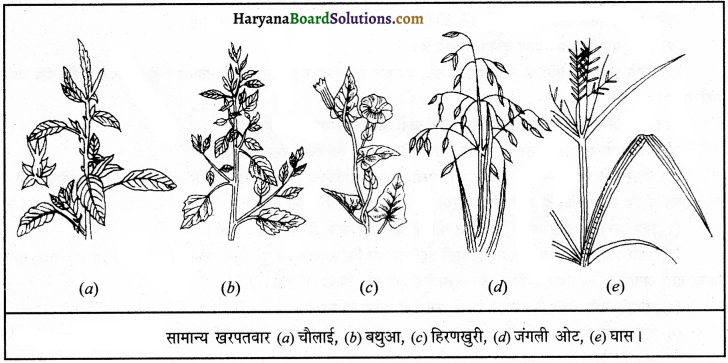
समाप्त करने की विधियाँ-खरपतवार को समाप्त करने की विधियाँ निम्नलिखित हैं-
- यदि ये खरपतवार कम मात्रा में हो तो, इन्हें समाप्त करने के लिए हाथ से या खुरपे से निकालकर फेंक दिया जाता है।
- हल चलाते समय भी खरपतवार जड़-सहित उखाड़कर निकाल दी जाती है।
- यदि खरपतवार अधिक मात्रा में हो तो खरपतवारनाशी रसायनों का छिड़काव करते हैं। ये रसायन फसल को नुकसान पहुँचाए बिना इसे नष्ट कर देते हैं। कुछ खरपतवारनाशक 2-4-D, M.P.C.A., ब्यूटाक्लोर आदि हैं।
- इस विधि में खेत में खरपतवार को नष्ट करने के लिए जीवों का सहारा लिया जाता है; जैसे ओपेंशिया नामक खरपतवार को कोबोनियल कीट नष्ट कर देता है।
- मिश्रित फसलीकरण, अंतराफसलीकरण और फसल-चक्र अपनाकर भी खरपतवार नष्ट किए जा सकते हैं।
प्रश्न 34.
फसल संरक्षण किसे कहते हैं? इसकी आवश्यकता क्या है?
उत्तर:
फसलों को जीवाणु रोगों, फफूंदी रोगों, कीटों तथा अन्य पीड़कों से बचाना फसल संरक्षण कहलाता है। यदि फसल संरक्षण न किया जाए तो कृषि पैदावारों; जैसे अनाज, फल, सब्जियों तथा अन्य उत्पादों को भारी नुकसान होता है। इसलिए खेतों में उगाई गई फसलों को उन नाशक जीवों तथा रोगों से सुरक्षा प्रदान करना अति आवश्यक है जिनसे फसल को नुकसान पहुँचता है। ऐसा न करने से उत्पादक को भारी नुकसान उठाना पड़ता है।
प्रश्न 35.
खरपतवार को हटाना क्यों आवश्यक है?
उत्तर:
खरपतवार को फसलों से हटाया जाता है क्योंकि खरपतवार या अवांछित पौधे अपना भोजन फसल के पौधों के लिए दिए गए पानी तथा पोषक तत्त्वों से प्राप्त करते हैं जिससे फसल की पैदावार कम हो सकती है। इसलिए अधिक उत्पादन के लिए फसलों में से खरपतवार निकाल देते हैं ताकि पानी और पोषक तत्त्वों की आपूर्ति फसल के लिए पर्याप्त मात्रा में हो सके और पैदावार अधिक मिले।
प्रश्न 36.
कीट-पीड़क कितने प्रकार से पौधों पर आक्रमण करते हैं?
उत्तर:
कीट-पीड़क तीन प्रकार से पौधों पर आक्रमण कर उन्हें हानि पहुँचाते हैं; जैसे-
- ये मूल, तने तथा पत्तियों को काट देते हैं।
- ये पौधों के विभिन्न भागों से कोशिकीय रस चूस लेते हैं।
- ये तने तथा फलों में छिद्र कर उन्हें क्षतिग्रस्त करते हैं।
प्रश्न 37.
पीड़कनाशियों के प्रयोग से होने वाले लाभ और हानियों का वर्णन करो।
उत्तर:
लाभ-पीड़कनाशियों के प्रयोग से कृषि उत्पादन में बहुत वृद्धि होती है। हानियाँ-
- इनके प्रयोग से हानिकारक कीटों के साथ लाभदायक कीट भी मर जाते हैं।
- इनके प्रयोग से पर्यावरण दूषित हो रहा है।
- इनके प्रयोग से भूमि के नीचे नाइट्रेट तथा फास्फेट की मात्रा बढ़ जाने से जल विषाक्त हो जाता है जोकि पीने योग्य नहीं रहता।

प्रश्न 38.
अन्न भंडारण के लिए किन-किन बातों का ध्यान रखना चाहिए?
उत्तर:
अन्न के सुरक्षित भंडारण के लिए निम्नलिखित बातों का ध्यान रखना चाहिए-
(1) भंडारण से पूर्व अन्न को खुली धूप में सुखाकर यह सुनिश्चित कर लेना चाहिए कि अन्न में 14% से अधिक नमी न रहे। शुष्क व ठंडे अनाज को ही उपचारित बोरियों या अन्न साइलों में रखना चाहिए।
(2) फिर अन्न को ठंडा करके उपचारित बोरियों या अन्न पात्रों में भर देना चाहिए।
(3) भंडारण के लिए पात्र की बनावट ऐसी होनी चाहिए कि समय-समय पर अन्न का निरीक्षण किया जा सके तथा धूमन क्रिया द्वारा अनाज के हानिकारक कीटों और सूक्ष्मजीवों को नष्ट किया जा सके।
(4) भंडारण नमी रहित व हवादार स्वच्छ कमरों में करना उचित है।
(5) चूहों आदि से बचाने के लिए अनाज को धातु की टंकी में भंडारित करना चाहिए।
(6) भंडारित अन्न का समय-समय पर निरीक्षण करना चाहिए।

प्रश्न 39.
भंडारित अनाज में कीटों को किस प्रकार नियंत्रित किया जा सकता है?
उत्तर:
भंडारित अनाज में कीटों तथा सूक्ष्मजीवों की संख्या को कम करने की अनेक विधियाँ हैं। कीटों का नियंत्रण कीटों के नियंत्रण के लिए निम्नलिखित उपाय करने चाहिएँ-
1. छिड़काव भंडारों में अनाज आने से पहले कीट-रहित तथा संक्रमण रहित करने के लिए छिड़काव अधिक उपयुक्त है। मैलथियोन तथा पायरेथ्रम पीड़कनाशकों के दो सामान्य उदाहरण हैं।
2. धूमन-जब अनाज भंडारित किया जाता है तब कीटों की संख्या को नियंत्रित करने के लिए धूमन विधि उपयुक्त है। यह वाष्पशील रसायन होता है जिसका शीघ्र ही वाष्पन हो जाता है और वह अनाज को बिना प्रभावित किए ही कीटों को नष्ट कर देता है। … उदाहरण-एथीलीन डाईब्रोमाइड (E.D.B.) तथा ऐलुमिनियम फॉस्फाइड।
प्रश्न 40.
पशुपालन की परिभाषा लिखिए।
उत्तर:
कृषि विज्ञान की वह शाखा पशुपालन कहलाती है जिसमें पशुओं के पालन-पोषण, आहार, प्रजनन, उनके आश्रयस्थलों तथा रोगों से उनकी रक्षा का अध्ययन किया जाता है। पशुओं की नस्ल सुधारना पशुपालन का एक मुख्य अंग है। पशुपालन का उद्देश्य पशुओं से अधिक-से-अधिक लाभ प्राप्त करना तथा उन्हें मनुष्य के लिए अधिक उपयोगी बनाना है।
प्रश्न 41.
मवेशियों को चारे में क्या-क्या दिया जाना चाहिए?
उत्तर:
मवेशियों को चारे में हरा चारा, भूसा, सूखी-घास, तिपतिया चारा, चोकर, चने के छिलके, खल आदि दिए जाने चाहिएँ। अधिकतर मवेशी शाकाहारी होते हैं। कुछ दुधारू मवेशियों को बिनौले, मेथी तारामीरा, गुड़ आदि का मिश्रण भी दिया जाता है।
प्रश्न 42.
पालतू बनाना किसे कहते हैं? किन्हीं चार पालतू जानवरों के नाम लिखो।
उत्तर:
जब पशु की आवश्यकताएँ; जैसे भोजन, आश्रय, सुरक्षा, स्वास्थ्य आदि की पूर्ति मनुष्य के द्वारा की जाए और इसी वातावरण में रहते हुए ये पशु प्रजनन कर वंश वृद्धि करें तो इसे पालतू बनाना कहते हैं।
पालतू जानवरों के नाम-

प्रश्न 43.
किन उपायों द्वारा देश में जंतु स्रोत से प्राप्त खाद्य उत्पादन को बढ़ाया जा सकता है?
उत्तर:
पशुओं द्वारा प्राप्त खाद्य पदार्थों में विशेष रूप से दूध और मांस हैं। इन खाद्य पदार्थों का उत्पादन संकरण द्वारा बढ़ाया जा सकता है। उदाहरण के लिए देशी गाय प्रतिदिन औसतन 6 से 8 लीटर दूध देती है जबकि संकर नस्ल की गाय लगभग 60 लीटर तक दूध प्रतिदिन देती है।
पशुओं की नस्ल सुधार द्वारा पशु खाद्य उत्पादन बढ़ाया जा सकता है। इसके अतिरिक्त पशुओं को संतुलित आहार प्रदान कर तथा साफ-सुथरे आवास में पशुओं को रख कर भी उत्पादन बढ़ाया जा सकता है। बीमार-पशुओं में उत्पादन घट जाता है। अतः पशुओं को निरोग बनाए रखने से उत्पादन में वृद्धि होती है।
प्रश्न 44.
दुग्धस्रवण काल तथा शुष्क काल किसे कहते हैं?
उत्तर:
दुग्धस्रवण काल-दुधारू पशुओं में दूध देने का समय (बछड़े के जन्म देने से सगर्भता तक), दुग्धस्रवण काल कहलाता है। शुष्क काल या ड्राई पीरियड-दुधारू पशुओं में वह समय जब वे दूध नहीं देते अर्थात् सगर्भता से बछड़े के जन्म तक का समय शुष्क काल कहलाता है।
प्रश्न 45.
अच्छी पशु-आवास व्यवस्था की क्या विशेषताएँ हैं?
उत्तर:
पशुपालन में आवास स्थान का अपना महत्त्वपूर्ण स्थान है। इसकी निम्नलिखित विशेषताएँ होनी आवश्यक हैं-
- आवास-स्थान खुला एवं हवादार होना चाहिए।
- आवास-स्थान नमी से मुक्त हो। यह साफ तथा प्रकाशयुक्त होना चाहिए।
- पशुओं के मल-मूत्र (गोबर-मूत्र) की निकासी का उचित प्रबंध होना आवश्यक है।
- आवास-स्थान पशुओं का गर्मी, धूप, आंधी, वर्षा से बचाव करने वाला होना चाहिए।
- आवास-स्थान प्रदूषण रहित होना चाहिए।
- आवास-स्थान में जल की उचित व्यवस्था होनी चाहिए।
- कुक्कुट आदि में यह उनके शत्रुओं से सुरक्षित होना चाहिए।
प्रश्न 46.
हमारे देश में देशी नस्ल की दुधारू गायें कौन-कौन सी होती हैं?
उत्तर:
देशी नस्ल की दुधारू गाएँ मुख्यतः तीन प्रकार की होती हैं-
1. रेडसिंधी-यह गाय लाल रंग की होती है जिस पर गहरे तथा हल्के लाल चकते होते हैं। यह मध्यम आकार की होती है।
2. साहीवाल-अन्य दुधारू गायों की तुलना में यह नस्ल उत्तम है। इसका शरीर आकार में बड़ा एवं भारी होता है।
3. गिर-यह नस्ल गुजरात के गिर जंगलों की मूल नस्ल है। ये गाएँ मध्यम आकार की और पर्याप्त मात्रा में दूध देने वाली होती हैं। डॉगी, देवनी, थारपरकर तथा हरियाणा द्विउद्देश्यीय नस्ल की गायें हैं जो पर्याप्त दूध देती हैं।
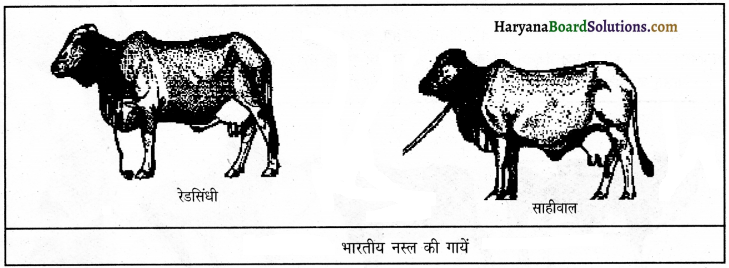
प्रश्न 47.
हमारे देश में संकर प्रजनन के लिए गायों की कुछ चयनित विदेशी नस्लें कौन-कौन सी हैं?
उत्तर:
हमारे देश में संकर प्रजनन के लिए निम्नलिखित चयनित विदेशी नस्ल की गायों को उपयोग में लाया जाता है-
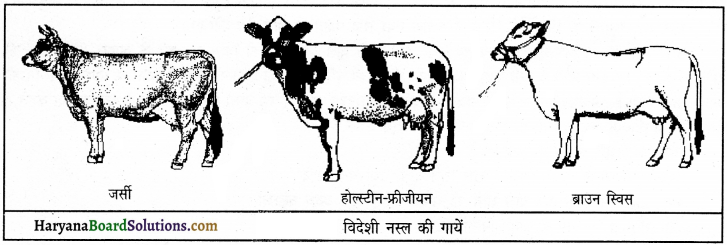
- जी यह गाय अमेरिका के जरसी द्वीप की मूल नस्ल है। यह एक उत्तम दुधारू गाय की नस्ल है।
- होल्स्टीन-फ्रीजीयन-यह मूलतः हॉलैंड की नस्ल है।
- ब्राउन स्विस-यह स्विट्ज़रलैंड की द्विउद्देशीय नस्ल है।
प्रश्न 48.
NDRI करनाल द्वारा विकसित गार्यो की उन्नत नस्लें कौन-कौन सी हैं?
उत्तर:
हमारे देश में उन्नत नस्ल की गाएँ करनाल स्थित राष्ट्रीय डेयरी अनुसंधान संस्थान (NDRI) द्वारा विकसित की गई हैं। कुछ सफल संकर नस्लें हैं-
- करन स्विस-यह ब्राउन स्विस एवं साहीवाल की संकर वर्ण नस्ल है।
- करन फ्राइस-यह थारपरकर तथा होल्स्टीन-फ्रीजीयन के बीच संकरण से विकसित हुई।
- फ्राइसवाल-होल्स्टीन-फ्रीजीयन तथा साहीवाल की संकर नस्ल। इन नई संकर नस्लों का दूध उत्पादन देशज गायों की तुलना में दो से तीन गुणा अधिक है।
प्रश्न 49.
अधिक दुग्ध-उत्पादन वाली भैंस की नस्ल का नाम लिखो। उसकी दूध देने की क्षमता लिखिए।
उत्तर:
अधिक दुग्ध-उत्पादन वाली भैंस की नस्ल मुर्रा है जो देशी नस्लों के 1800 लीटर की तुलना में 2500 लीटर दुग्ध का उत्पादन अपने दुग्धस्रवण काल में करती है। इसके अतिरिक्त अधिक दुग्ध-उत्पादन वाली नस्लें हैं-जाफराबादी, नागपुरी, सुरती।
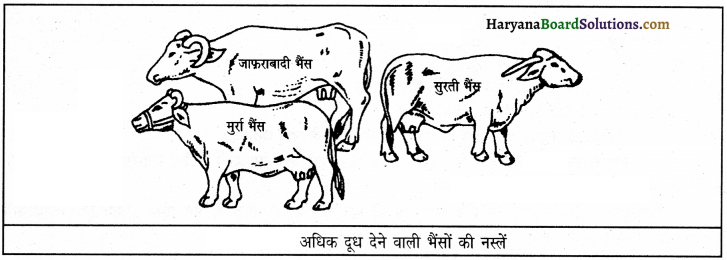
प्रश्न 50.
रूक्षांश किसे कहते हैं? पशु इसे कैसे प्राप्त करते हैं?
उत्तर:
मवेशियों के भोजन में सामान्यतः रेशायुक्त, दानेदार, कम पोषण वाली घास-फूस होती है, जिसे रूक्षांश कहते हैं। पशु को रूक्षांश हरा चारा, बरसीम, रिजका तथा सूखी घास के रूप में प्राप्त होती है।
प्रश्न 51.
दुग्धधारी पशुओं में आहार उनके दुग्ध-उत्पादन को किस प्रकार प्रभावित करता है?
उत्तर:
दुग्धधारी पशुओं में आहार उनके दुग्ध-उत्पादन को प्रभावित करता है तथा इसके विपरीत उनका आहार पशु के दूध देने की मात्रा पर निर्भर करता है। अधिक दूध देने वाले पशु को अच्छा पौष्टिक आहार देना पड़ता है। उसे यदि कम पौष्टिक आहार दिया जाएगा तो उसका दुग्ध-उत्पादन कम हो जाएगा।
दूध देने वाले पशुओं को रूक्षांश के रूप में रेशायुक्त दानेदार अनाज की भूसी, कम पोषण वाली घास-फूस तथा हरा चारा व सांद्र पदार्थ के रूप में अनाज, दालें, चना, बाजरा, तिलहन, खल, बिनौले (कपास के बीज) दिए जाते हैं। पौष्टिक आहार से दुग्धधारी मवेशियों का दुग्ध-उत्पादन लगभग तीन गुणा बढ़ाया जा सकता है।
प्रश्न 52.
पशुओं के भोजन के संदर्भ में रूक्षांश तथा सांद्र पदार्थ के बीच भेद कीजिए।
उत्तर:
जिस प्रकार विभिन्न आयु, स्वास्थ्य तथा कार्य करने वाले व्यक्तियों को विभिन्न प्रकार के आहार (पौष्टिकता की दृष्टि से) की आवश्यकता होती है उसी प्रकार पशुओं को भी उनकी वृद्धि आदि की दृष्टि से विभिन्न प्रकार के पौष्टिक भोजन की आवश्यकता होती है। मवेशियों के सामान्य भोजन में रेशायुक्त, दानेदार, कम पोषण वाली घास-फूस होती है, उसे रूक्षांश कहते हैं तथा एक या अधिक पोषक तत्त्व वाले पदार्थ को सांद्र पदार्थ कहते हैं।
सांद्र पदार्थ वाले भोजन के उदाहरण हैं – बिनौले (कपास के बीज), तिलहन, खल (तेल वाले) तथा चना आदि।
प्रश्न 53.
जानवरों में होने वाले रोगों की रोकथाम हेतु कुछ उपाय बताओ।
उत्तर:
रोगों से रोकथाम के उपाय निम्नलिखित हैं-
- जानवरों को साफ-सुथरे स्थान पर रखो।
- जानवरों का अनिवार्य टीकाकरण कराना चाहिए।
- पशुओं को संतुलित आहार प्रदान करो।
- पशुओं की शारीरिक सफाई के लिए उनके स्थान को साफ करना चाहिए।
- बीमारियों के लिए पशुओं की नियमित जांच कराना अनिवार्य है।
- मृत पशुओं तथा पशुओं के मल-मूत्र का उचित निष्पादन करना चाहिए।
प्रश्न 54.
रोगी पशु के लक्षण लिखो।
उत्तर:
रोगी पशु के लक्षण निम्नलिखित हैं-
- यह धीरे-धीरे घिसटकर चलता है।
- यह सुस्त और थका होता है।
- इसकी त्वचा शुष्क और आभा रहित होती है।
- यह भोजन करना बंद कर देता है।
- इसके कान गिरे-गिरे दिखाई देते हैं।
- इसे सांस लेने में कठिनाई होती है।
- यह पतला या कड़ा दुर्गंधयुक्त मल का त्याग करता है।
- इसका स्वभाव चिड़चिड़ा हो जाता है।

प्रश्न 55.
किन्हीं दो जीवाणु-जन्य तथा विषाणु-जन्य पशु रोगों के नाम बताइए।
उत्तर:
- जीवाणु-जन्य रोग-जीवाणुओं से होने वाले रोगों को जीवाणु-जन्य रोग कहते हैं; जैसे हैजा (मुर्गी), अतिसार (चूजों), क्षयरोग (मवेशियों तथा पक्षियों), रिंडरपेस्ट (मवेशियों)।
- विषाणु-जन्य रोग-विषाणुओं से होने वाले रोगों को विषाणु-जन्य रोग कहते हैं; जैसे चेचक (गाय, भैंस), त्वक शोथ (भेड़-बकरी), मुंह-खुर (मवेशियों)।
प्रश्न 56.
कुक्कुट पालन क्यों किया जाता है?
उत्तर:
कुक्कुट पालन अधिकतर मांस और अंडे प्राप्त करने के लिए किया जाता है। इनके पंख भी उपयोगी होते हैं। मुर्गे का औसत वजन 4 से 5 किलोग्राम व मुर्गी का 3 से 4 किलोग्राम तक होता है।
प्रश्न 57.
लेअर और ब्रौलर के आहार में भिन्नता क्यों होती है?
उत्तर:
लेअर का पालन अंडे प्राप्त करने के लिए किया जाता है। अतः लेअर के आहार में अन्न के दाने, सूखी मछली अधिक होती है, जबकि ब्रौलर को मांस प्राप्ति के लिए पाला जाता है। ब्रौलर के आहार में प्रोटीन, वसा तथा विटामिन A तथा K अधिक मात्रा में होते हैं।
प्रश्न 58.
हमारे देश में उपयोग में आने वाली कुक्कुट की विदेशी नस्लों का वर्णन करो।
उत्तर:
हमारे देश में निम्नलिखित विदेशी कुक्कुट नस्लें उपयोग में आती हैं-
1. व्हाइट लेगहान-यह लंबे सफेद अंडे देने वाली मशहूर नस्ल है। यह अधिक लोकप्रिय इसलिए है क्योंकि इसके शरीर का आकार छोटा होता है, जिससे इसके पालन-पोषण में कम आहार की आवश्यकता होती है।
2. रोडे आईलैंड रेड-यह नस्ल अमेरिका के रोडे आईलैंड फार्म में विकसित की गई है। यह द्विउपयोगी नस्ल है। यह अधिक अंडे एवं मांस प्रदान करने वाली (broiler) नस्ल है।
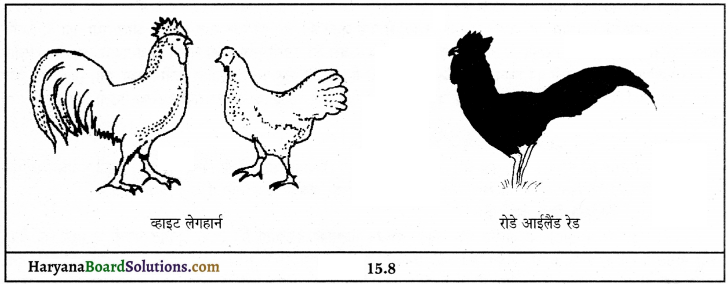
प्रश्न 59.
कुक्कुट की देशी, विदेशी और संकर नस्लों के नाम लिखो।
उत्तर:
कुक्कुट की देशी, विदेशी और संकर नस्लों का वर्णन इस प्रकार है-
1. देशी नस्लें आसील, बसारा, चिटागांग, धागस।
2. विदेशी नस्लें व्हाइट लेगहान, रोडे आइलैंड रेड, पलाईमाउथ रॉक, आस्ट्रेलाप।
3. संकर नस्लें-HH-260, IBL-80, B-77

प्रश्न 60.
कुक्कुटों की देखभाल में किन बातों का ध्यान रखना चाहिए?
उत्तर:
कुक्कुटों की देखभाल के लिए निम्नलिखित बातों का ध्यान रखना चाहिए-
- इनको रहने के लिए पर्याप्त स्थान की आवश्यकता है। अति संकुलता से इनकी वृद्धि कम हो जाती है।
- लेअर को पर्याप्त स्थान एवं उचित प्रकाश की आवश्यकता होती है। प्रकाश की तीव्रता एवं अवधि का मुर्गी के अंडा देने की क्षमता पर अनुकूल प्रभाव पड़ता है।
- मुर्गियों को उचित आहार देना चाहिए। कुक्कुट आहार में विटामिन A और K की मात्रा अधिक होनी चाहिए। ब्रौलर के आहार में प्रोटीन तथा वसा होनी चाहिए।
- कुक्कुटों की नियमित स्वच्छता और सफाई रखनी चाहिए।
- समुचित टीकाकरण से संक्रमणीय बीमारियों की रोकथाम की जानी चाहिए।
प्रश्न 61.
कुक्कुट की नई नस्लें देशी नस्लों की तुलना में किस प्रकार उपयोगी हैं? उदाहरण सहित वर्णन करो।
उत्तर:
कुक्कुट की नई नस्लों का आहार कम है परंतु अंडे तथा मांस का उत्पादन अधिक है; जैसे नई नस्ल को 12 अंडे उत्पन्न करने के लिए 2 किलोग्राम आहार की आवश्यकता है, जबकि देशी नस्ल को इसके लिए 6 किलोग्राम आहार की आवश्यकता होती है।
नई नस्ल को 1 किलोग्राम मांस उत्पादन के लिए 2-3 किलोग्राम आहार की आवश्यकता होती है, जबकि देशी नस्ल को इसके लिए 5-6 किलोग्राम आहार की आवश्यकता होती है।
प्रश्न 62.
मछलियाँ कहाँ पाई जाती हैं?
उत्तर:
मछलियाँ लवणीय और अलवणीय जल स्रोतों में पाई जाती हैं। अलवण जल स्रोत तालाब, झील तथा नदी हैं, जबकि लवण जल समुद्र का होता है। समुद्र के तटीय क्षेत्रों के लोग लवण जल की मछली तथा अन्य समुद्री खाद्य पदार्थ खाते हैं। स्थलीय लोग अलवणीय जल की मछली का सेवन भोजन के रूप में करते हैं। कटला, रोहु, मुलेट अलवण जलीय तथा टुना, शार्क और कॉड लवणीय मछलियाँ हैं। हमारे देश में 16 लाख हेक्टेयर अंतस्थलीय क्षेत्र तथा 7500 किलोमीटर लंबी तटरेखा मछली उत्पादन के लिए उपयुक्त है।
प्रश्न 63.
मछलियों को भोजन के रूप में कैसे खाया जाता है?
उत्तर:
मछलियों को ताजा रूप में, सुखाकर, आचार बनाकर तथा डिब्बाबंद करके सेवन किया जाता है। समुद्री मछलियाँ अधिक मात्रा में पकड़ी जाती हैं। अतः इनका परिरक्षण सुखाकर, आचार बनाकर अथवा अन्य विधियों द्वारा किया जाता है।
प्रश्न 64.
मात्स्यकी किसे कहते हैं?
उत्तर:
बड़े स्तर पर मछलियाँ पालना और उनका प्रबंधन मात्स्यकी कहलाता है। इसके अंतर्गत मछली के अंडों को सेकर शिशु मछलियाँ (बीज) प्राप्त करना, उचित जल स्रोत (निवास) वाले पानी में उचित संख्या में मछलियाँ रखना, उचित आहार देना, पर्याप्त ऑक्सीजन व प्रकाश वाले टैंकों में मत्स्य बीज की उचित संख्या लेकर संवर्धन करना तथा इनकी उपज प्राप्त करना आता है।
प्रश्न 65.
मिश्रित मछली संवर्धन किसे कहते हैं? इस विधि में भोजन के लिए स्पर्धा के न होने का कारण क्या है?
उत्तर:
किसी धान के खेत या अकेले तालाब में 5-6 मछली की स्पीशीज़ को एक साथ पाला जाता है। इसे मिश्रित मछली संवर्धन कहते हैं। मछली संवर्धन में आहार के लिए कोई स्पर्धा नहीं होती क्योंकि कटला मछली पानी की सतह से, रोहु तालाब के मध्य से, मृगल व कॉमन कार्प तालाब की तली से भोजन लेती हैं, जबकि ग्रास कार्प खरपतवार खाकर जीवन-निर्वाह करती है। इस प्रकार इनमें कोई स्पर्धा नहीं होती और तालाब से मिश्रित मछली संवर्धन से उत्पादन में काफी वृद्धि होती है।
प्रश्न 66.
मिश्रित मछली संवर्धन में एक समस्या क्या है?
उत्तर:
मिश्रित मछली संवर्धन में पाली जाने वाली कई मछलियाँ केवल वर्षा ऋतु में ही जनन करती हैं जिसके कारण अन्य महीनों में अच्छी गुणवत्ता वाले डिम्भ नहीं मिल पाते। अतः मछली संवर्धन नहीं हो सकता।
प्रश्न 67.
मधुमक्खी पालन पर नोट लिखो।
उत्तर:
मधुमक्खियाँ पालने के काम को मौन पालन भी कहते हैं। मधु प्राप्त करने के लिए मधुमक्खियों को कृत्रिम छत्ते बनाकर पाला जाता है। पालतू मधुमक्खियों के लिए डिब्बे के आकार के विशेष छत्ते बनाए जाते हैं जिनके अंदर मोम की पतली परत से बने मधुकोषों में खांचे जड़ दिए जाते हैं। पालतू मधुमक्खियाँ फूलों के मकरंद से शहद (मधु) बनाकर इन खांचों में भर देती हैं अब इस शहद को शहद निकालने वाली मशीन से निकाल लिया जाता है।

प्रश्न 68.
मधुमक्खियों के लाभ लिखो।
उत्तर:
मधुमक्खियों से होने वाले लाभ निम्नलिखित हैं-
- मधुमक्खियों से शहद मिलता है। शहद एक पौष्टिक आहार है और एंटीबायोटिक पदार्थ है।
- इनसे मोम भी मिलता है। मोम का उपयोग औषधि निर्माण में किया जाता है।
- मधुमक्खियाँ पर-परागण में सहायक हैं जिससे पौधों की पैदावार भी बढ़ जाती है। विशेष बागों में फलों का उत्पादन बढ़ जाता है।
- किसानों को मधुमक्खी पालन से अतिरिक्त आय होती है।
प्रश्न 69.
व्यावसायिक स्तर पर कौन-कौन सी मधुमक्खी की किस्में पाली जाती हैं?
उत्तर:
व्यावसायिक स्तर पर मधुमक्खी की पाली जाने वाली किस्में निम्नलिखित हैं-
- ऐपिस सेरना इंडिका (भारतीय मक्खी)।
- ऐपिस डोरसेटा (एक शैल मक्खी)।
- ऐपिस फ्लोरी (लिटिल मक्खी)।
- ऐपिस मेलीफेरा (इटेलियन मक्खी)।
उपर्युक्त सभी मधुमक्खी किस्में शहर व मोम के उत्पादन के लिए पाली जाती हैं। सभी खेतों और बागों की पैदावार में भी वृद्धि करती है। उनके पालने का स्थान मधुवाटिका या मधुमक्खी फार्म कहलाता है।
निबंधात्मक प्रश्न
प्रश्न 1.
भारत में कौन-कौन सी सिंचाई प्रणालियाँ अपनाई जाती हैं?
उत्तर:
भारत में सिंचाई के लिए निम्नलिखित प्रणालियाँ अपनाई जाती हैं-
1. नहर प्रणाली-नहर प्रणाली में नहरों को जलाशयों या नदियों से पानी मिलता है। मुख्य नहर से छोटी नहर और छोटी नहरों से शाखा नहरें निकाली जाती हैं। इनसे नालियाँ खेतों को पानी ले जाती हैं। नहर द्वारा सिंचाई किए जाने से खेतों को पानी पर्याप्त रूप में मिलता है।
2. तालाब प्रणाली-छोटे-छोटे जलाशयों को तालाब कहते हैं। आस-पास के क्षेत्रों का पानी तालाबों में एकत्र हो जाता है। तालाबों के जल के बाहर होने वाले बहाव को जल की उपलब्धता के अनुसार नियंत्रित किया जाता है। तालाबों द्वारा सिंचाई भारत के दक्षिण भागों में ही की जाती है।
3. कुएँ-जिन क्षेत्रों में भूमिगत जल उपलब्ध होता है, वहाँ पर कुएँ बनाए जाते हैं। कुएँ दो प्रकार के होते हैं-खोदे हुए कुएँ और नलकूप । कुएँ में भूमिगत जल को उपयोग में लाया जाता है। खोदे गए कुओं से सिंचाई के लिए पानी यांत्रिक साधनों; जैसे रहट द्वारा ऊपर उठाया जाता है।
4. नलकूप गहरी सतह से पानी डीज़ल या बिजली द्वारा चलित पंपों से ऊपर उठाया जाता है। नलकूप द्वारा सिंचाई करना सुनिश्चित सिंचाई प्रणाली है।
5. नदी घाटी प्रणाली-कर्नाटक और केरल के पश्चिमी घाट में नदियों द्वारा वर्षा का जल सिंचाई के लिए उपयोग किया जाता है। इन क्षेत्रों में गहरी और संकरी घाटियों के बीच बहने वाली नदियाँ बहुवर्षी फसलों; जैसे नारियल, रबड़, कॉफी, टैपियोका आदि को पानी उपलब्ध कराती हैं। तलहटी भूमि पर चावल की खेती की जाती है।
6. नदी जल उठाव प्रणाली जलाशयों में जल की कमी के कारण नहरों में पानी उपलब्ध करवाने के लिए जल उठाव प्रणाली उपयोग में लाई जाती है। नदियों पर जल उठाव प्रणाली द्वारा पानी नहरों तक लाया जाता है।
प्रश्न 2.
फसलों की किस्मों में सुधार लाने की क्या आवश्यकता है? फसलों की किस्मों में सुधार के उद्देश्यों का विवरण दीजिए।
उत्तर:
फसलों की किस्मों में सुधार की आवश्यकता मानव और पशुओं में निरंतर बढ़ती जनसंख्या के लिए खाद्यान्न, चारा, रेशा, चीनी और तेल आदि की माँग बढ़ती जा रही है, परंतु भू-संसाधन सीमित होने के कारण बढ़ती आवश्यकता की पूर्ति फसलों की उत्पादकता बढ़ाने से संभव हो सकती है। अतः फसल सुधार अर्थात् किस्म सुधार के द्वारा बढ़ती माँग को पूरा किया जा सकता है।
फसलों की किस्मों में सुधार के उद्देश्य-
- अधिक उपज लेने के लिए किस्म सुधार की आवश्यकता है।
- उत्तम गुणवत्ता वाले उत्पाद प्राप्त करने के लिए इसकी आवश्यकता होती है; जैसे दालों में प्रोटीन की मात्रा, फलों व सब्जियों में परिरक्षण की गुणवत्ता, तिलहन में तेल की गुणवत्ता आदि।
- फसलों में रोग प्रतिरोधी क्षमता विकसित करने के लिए किस्म सुधार की आवश्यकता है।
- अगेती और समान परिपक्वता के लिए कुछ लंबी अवधि वाली फसलों में गुण विकसित करने के लिए किस्म सुधार आवश्यक है।
फसलों में प्रकाश एवं ताप असंवेदनशीलता का गुण फसल किस्म सुधार से किया जा सकता है। इन कारकों के प्रति असंवेदी - किस्मों के विकास से खेती की सीमाएँ बढ़ाई जा सकती हैं।
- किस्म सुधार से फसलों में ऐच्छिक गुण; जैसे चारे वाली फसलों में लंबाई, अधिक फुटाव का गुण, कुछ धान्य फसलों में बौनापन का गुण, फलों में मिठास का गुण आदि विकसित किए जा सकते हैं।
- फसलों में व्यापक अनुकूलता वाली किस्मों का विकास कर, पर्यावरण की विभिन्न परिस्थितियों में फसल उत्पादन में स्थायीपन लाया जा सकता है।
प्रश्न 3.
खाद क्या होती है? यह कितने प्रकार की होती है? विस्तार से वर्णन करो।
उत्तर:
भूमि की उपजाऊ शक्ति को निरंतर बनाए रखने के लिए भूमि में कुछ विशेष पदार्थ मिलाने पड़ते हैं। इन्हीं विशेष पदार्थों को, जो भूमि में पोषक तत्त्वों की कमी को पूरा करते हैं, खाद कहते हैं। खाद मुख्य रूप से निम्नलिखित दो प्रकार की होती हैं-
- जैविक खाद (कार्बनिक खाद)।
- अजैविक खाद (अकार्बनिक खाद)।
1. जैविक खाद यह खाद जीव-जंतुओं और पौधों के अवशेषों, उनके मल पदार्थों तथा गले-सड़े कूड़े-कर्कट से तैयार की जाती है। जैविक खाद तीन प्रकार की होती है
- गोबर की खाद-यह खाद पशुओं के गोबर को गला-सड़ाकर तैयार की जाती है। इस खाद में पर्याप्त पोषक तत्त्व होते हैं।
- कंपोस्ट खाद-यह खाद घास-फूस, कूड़ा-कर्कट और सड़ी-गली वस्तुओं को गड्ढे में दबाकर तैयार की जाती है।
- हरी खाद-खड़े हुए छोटे-छोटे पौधों को हल चलाकर खेत में दबा देने से व उनके गलने-सड़ने से जो खाद बनती है, उसे हरी खाद कहते हैं।
2. अजैविक खाद-ये खादें कृत्रिम ढंग से तैयार की जाती हैं। इन्हें उर्वरक भी कहते हैं। ये भी तीन प्रकार की होती हैं-
- नाइट्रोजन उर्वरक ये वे उर्वरक हैं, जो भूमि को नाइट्रोजन तत्त्व प्रदान करते हैं; जैसे यूरिया, अमोनिया, सल्फेट आदि।
- फास्फेट उर्वरक ये वे उर्वरक हैं, जो भूमि को फास्फोरस तत्त्व प्रदान करते हैं; जैसे सुपर फास्फेट आदि।
- पोटैशियम उर्वरक-ये वे उर्वरक हैं, जो भूमि को पोटैशियम तत्त्व प्रदान करते हैं; जैसे पोटैशियम सल्फेट, पोटैशियम क्लोरेट आदि।
प्रश्न 4.
हरित क्रांति से आप क्या समझते हैं? इसके लाभ लिखिए।
उत्तर:
हमारे देश में सन् 1960 तथा 1980 के बीच के समय में उत्पादन में अत्यधिक वृद्धि को हरित क्रांति के नाम से जाना जाता है। इस समय में फसलों की उपज तथा उत्पादन में वृद्धि हुई जिससे भारत खाद्य पदार्थों के मामले में आत्म-निर्भर हो गया और अनाज का पर्याप्त सुरक्षित भंडार (बफर स्टॉक) बनाने में सफल हुआ।
इसलिए इस समय को सुनहरे युग के नाम से भी जाना जाता है। हरित क्रांति का आरंभ गेहूँ की उच्च उपजी किस्म (HYV) के विकास से हुआ जिसके अंतर्गत पारंपरिक और मैक्सिकन किस्म के संकरण से नई उच्च उपजी किस्म का विकास किया गया।
हरित क्रांति के लाभ निम्नलिखित हैं-
- इससे देश अन्न उत्पादन में आत्म-निर्भर हो गया।
- इससे अनाज का पर्याप्त सुरक्षित भंडार (बफर स्टॉक) इकट्ठा हो गया।
- पर्याप्त सुरक्षित भंडार से सूखे जैसी स्थितियों का सामना आसानी से किया गया।
- हरित क्रांति ने किसान की जीवन पद्धति को बदल दिया क्योंकि उनका लाभ बढ़ गया।
पदम विभूषण प्रो० एम० एस० स्वामीनाथन को भारत में हरित क्रांति का जनक माना जाता है। इसी कारण संयुक्त राष्ट्र पर्यावरण प्रोग्राम में डॉ० स्वामीनाथन को आर्थिक पारिस्थितिकी के पिता के रूप में सम्मान प्रदान किया है। हरित क्रांति के उपरांत अब भारत में दूसरी हरित क्रांति की बात की जाने लगी है।

प्रश्न 5.
कुक्कुट-पालन पर नोट लिखिए।
उत्तर:
इसमें कुक्कुट, बत्तख, हंस तथा टर्की आते हैं, परंतु कुक्कुट सबसे अधिक पाले जाते हैं। भारत में इसकी देशी तथा विदेशी दोनों प्रकार की नस्लें पाई जाती हैं।
1. देशी नस्लें हमारे देशी मुर्गियों की दो नस्लें असील तथा बलसारा हैं। इनके गुण निम्नलिखित हैं
- ये छोटी होती हैं
- ये कम वृद्धि करने वाली होती हैं
- ये छोटे-छोटे अंडे देती हैं
- ये पुष्ट होती हैं
- इनका उपयोग माँस के रूप में किया जाता है
- इनकी प्राकृतिक रोधक्षमता अपेक्षाकृत अधिक होती है।
2. विदेशी नस्लें इनमें व्हाइट लेगहार्न तथा रोडे आइलैंड रैड नस्लें प्रमुख हैं। इनके गुण निम्नलिखित हैं-
- ये बड़ी होती हैं
- ये शीघ्र वृद्धि करती हैं
- ये अधिक अंडे देती हैं
- इनके अंडों का आकार बड़ा होता है
- ये जल्दी बीमार हो जाती हैं।
3. नई नस्लें इन्हें देशी तथा विदेशी नस्लों के संकरण से प्राप्त किया जाता है। इनमें प्रमुख नस्लें ILS-82, B-77 हैं। इनमें निम्नलिखित गुण पाए जाते हैं
- इनमें देशी तथा विदेशी दोनों नस्लों के गुण पाए जाते हैं
- इनकी उत्पादन क्षमता लगभग 200 अंडे प्रति पक्षी प्रतिवर्ष है
- इन्हें आहार की कम आवश्यकता होती है
- इनसे अधिक मात्रा में मांस की प्राप्ति होती है।
भोजन-इनके भोजन में अनाज, गीला मिश्रण, हरे पदार्थ, चावल के बारीक छिलके तथा पानी शामिल हैं। पेट छोटा होने के कारण ये दिन में कई बार भोजन करती हैं।
कुक्कुट-पालन से अंडे, मांस, खाद तथा धन की प्राप्ति होती है।
प्रश्न 6.
मत्स्य पालन पर एक विस्तृत नोट लिखो।
उत्तर:
मछली एक जलीय जीव है और प्रोटीन का समृद्ध स्रोत है। इसका उत्पादन जल कृषि के अंतर्गत किया जाता है। हमारे देश में 16 लाख हेक्टेयर अंतःस्थलीय जलीय क्षेत्र तथा 7500 किलोमीटर लंबी तटरेखा मछली उत्पादन के लिए उपयुक्त है। आवास के आधार पर मछलियाँ निम्नलिखित प्रकार की होती हैं-
- अलवण या मृदु जलीय मछलियाँ
- लवणीय या समुद्री मछलियाँ
- बॅकिश पानी की मछलियाँ।
1. अलवण या मूदु जलीय मछलियाँ-तालाबों, नदियों, झीलों और झरनों में अलवणीय मछलियाँ पाई जाती हैं। इनमें कटला, रोहु, मृगल, सिल्वर कार्प तथा ग्रास कार्प प्रमुख हैं। कटला सबसे तेज वृद्धि करने वाली मछली है।
2. समुद्री मछलियाँ-समुद्र और खारे पानी में भारी संख्या में मछलियाँ पाई जाती हैं और ये मछलियाँ प्रमुख समुद्री खाद्य पदार्थ हैं। समुद्र में पाई जाने वाली मछलियों में रिबन मछली, कैट फिश, सारडाइन, शार्क, हिल्सा, पलाडेग फिश प्रमुख हैं।
3. ब्रैकिश मछली-ये मछलियाँ लहरों से आए एकत्रित पानी में पाई जाती हैं। पर्लस्थोट और मुलेट इनके उदाहरण हैं।
मछलियों के शत्रु-भंग, जलीय शलभ, मेंढक, सांप और पक्षी छोटी व बड़ी मछलियों के शत्रु हैं।
मछलियों की बीमारियाँ मछलियों में बीमारी के मुख्य कारक जीवाणु और विषाणु हैं। IPN (इंफेक्सीयस पैंक्रियाटिक नेक्रासिस) तथा VHS (वायरल हीमोरेजिक सेप्टीसेमिया) मछलियों में पाई जाने वाली प्रमुख संक्रमणीय बीमारियाँ हैं। जल प्रदूषण से भी मछली उत्पादन को भारी क्षति पहुँच रही है। मछली उत्पादन को बढ़ाने के लिए पूरे देश में मत्स्य पालकों को छोटे तथा बड़े स्तर की मत्स्यशालाएँ उपलब्ध हैं।
प्रयोगात्मक कार्य
क्रियाकलाप 1.
अनाज, दाल, तिलहन के बीजों का संग्रह करना व उनके उगाने व कटाई के मौसम के बारे में जानना।
कार्य-विधि-अपने माता-पिता की सहायता पाकर विभिन्न बीजों का संग्रह करो और गाँव के किसान से इन बीजों के उगाने व कटाई के मौसम के बारे में जानकारी प्राप्त करो।
| क्रमांक | बीज का नाम | उगाने का समय | कटाई का समय |
| 1. | धान | जून-जुलाई | अक्तूबर |
| 2. | मक्का | जून-जुलाई | अक्तूबर |
| 3. | मूंग | जून-जुलाई | अक्तूबर |
| 4. | सोयाबीन | जून-जुलाई | अक्तूबर |
| 5. | गेहूँ | अक्तूबर-नवंबर | अप्रैल-मई |
| 6. | चना | अक्तूबर-नवंबर | मार्च-अप्रैल |
| 7. | सरसों | अक्तूबर-नवंबर | मार्च-अप्रैल |
अध्याय का तीव्र अध्ययन
1. हमें भोजन प्राप्त होता है-
(A) केवल जंतुओं से
(B) केवल पौधों से
(C) पौधों और जंतुओं दोनों से
(D) अनाज भंडारों से
उत्तर:
(C) पौधों और जंतुओं दोनों से
2. वृहत पोषक संख्या में हैं-
(A) 6
(B) 7
(C) 13
(D) 3
उत्तर:
(A) 6
3. हरे पौधों के गलने-सड़ने से खाद बनती है-
(A) कंपोस्ट खाद
(B) वर्मीकंपोस्ट
(C) हरित खाद
(D) उर्वरक
उत्तर:
(C) हरित खाद
4. ब्रौलर को पाला जाता है-
(A) केवल अंडों के लिए
(B) केवल मांस के लिए
(C) अंडों व मांस दोनों के लिए
(D) मनोरंजन के लिए
उत्तर:
(B) केवल मांस के लिए
5. ताजे पानी वाली मछली नहीं है-
(A) कटला
(B) रोहु
(C) मिलिटस
(D) टुना
उत्तर:
(D) टुना
6. मधुमक्खी शहद बनाती है-
(A) फलों से
(B) मकरंद से
(C) पराग से
(D) मकरंद व पराग दोनों से
त्तर:
(D) मकरंद व पराग दोनों से
7. सूडान एक फसल है-
(A) धान्य
(B) चारा
(C) सब्जी
(D) मसाला
उत्तर:
(B) चारा

8. रबी की फसल नहीं है-
(A) अलसी
(B) सरसों
(C) मटर
(D) उड़द
उत्तर:
(D) उड़द
9. मूंग, पटसन, ढेंचा फसलें कहलाती हैं-
(A) दलहन
(B) तिलहन
(C) हरी खाद
(D) धान्य
उत्तर:
(C) हरी खाद
10. दो अथवा दो से अधिक फसलों को निश्चित कतार पैटर्न में उगाने को ………………… कहते हैं।
(A) अंतराफसलीकरण
(B) फसल चक्र
(C) मिश्रित फसल
(D) मिश्रित खेती तंत्र
उत्तर:
(A) अंतराफसलीकरण
11. मुर्गी की देशी नस्ल है-
(A) एसिल
(B) आइलैंड रैड
(C) व्हाइट लेगहार्न
(D) ILS – 82
उत्तर:
(A) एसिल
12. अलवणीय मछली है-
(A) प्रॉन
(B) टुना
(C) मस्सल
(D) पर्लस्पॉट
उत्तर:
(B) टुना
13. कार्बनिक खेती में उपयोग किया जाता है-
(A) जैविक खाद का
(B) उर्वरकों का
(C) पीड़कनाशी का
(D) शाकनाशी का
उत्तर:
(A) जैविक खाद का
14. दाल देने वाले पौधे मृदा में बढ़ाते हैं-
(A) फास्फोरस की मात्रा
(B) पोटैशियम की मात्रा
(C) नाइट्रोजन की मात्रा
(D) कार्बन की मात्रा
उत्तर:
(C) नाइट्रोजन की मात्रा
15. खरपतवारनाशक नहीं है-
(A) 2-4-D
(B) MPCA
(C) ब्यूटाक्लोर
(D) मैलाथीऑन
उत्तर:
(D) मैलाथीऑन
16. हमारे देश में संकर प्रजनन के लिए गायों की चयनित विदेशी नस्ल है-
(A) साहीवाल
(B) करन फ्राइस
(C) फ्राइसवाल
(D) ब्राउन स्विस
उत्तर:
(D) ब्राउन स्विस
17. मुर्गे का औसत वजन 4 से 5 कि०ग्रा० होता है जबकि मुर्गी का औसत वजन होता है-
(A) 2 से 3 कि०ग्रा०
(B) 3 से 4 कि०ग्रा०
(C) 5 से 6 कि०ग्रा०
(D) इनमें से कोई नहीं
उत्तर:
(B) 3 से 4 कि०ग्रा०
18. खरपतवार पर निर्वाह करने वाली मछली है-
(A) ग्रास कार्प
(B) कार्प (मृगल)
(C) कटला
(D) रोहु
उत्तर:
(A) ग्रास कार्प
19. यूरिया एक उर्वरक है-
(A) फॉस्फेटिक
(B) नाइट्रोजनी
(C) पोटाशिक
(D) मिश्रित
उत्तर:
(B) नाइट्रोजनी
20. मिश्रित उर्वरक है-
(A) पोटाश
(B) यूरिया
(C) NPK
(D) सोडियम नाइट्रेट
उत्तर:
(C) NPK
21. अच्छे अडे देने वाली नस्ल है-
(A) HH-260
(B) B-77
(C) ILS-82
(D) व्हाइट लेगहार्न
उत्तर:
(A) HH-260
22. निम्नलिखित में से किसमें कार्बन पाई जाती है?
(A) प्रोटीन में
(B) कार्बोहाइड्रेट्स में
(C) वसा में
(D) उपर्युक्त सभी
उत्तर:
(D) उपर्युक्त सभी
23. फसल उत्पादन में वृद्धि का कारण है-
(A) हरित क्रांति
(B) श्वेत क्रांति
(C) नील क्रांति
(D) जन क्रांति
उत्तर:
(A) हरित क्रांति
24. हमारे देश की अधिकतर जनसंख्या जीवन-यापन के लिए निर्भर रहती है-
(A) केंद्र सरकार पर
(B) राज्य सरकार पर
(C) कृषि पर
(D) सरकारी नौकरी पर
उत्तर:
(C) कृषि पर
25. खरीफ की फसलें किस ऋतु में उगाई जाती हैं?
(A) वर्षा ऋतु में
(B) ग्रीष्म ऋतु में
(C) बसंत ऋतु में
(D) शीत ऋतु में
उत्तर:
(A) वर्षा ऋतु में
26. निम्न में से किससे प्रोटीन प्राप्त होगी?
(A) उड़द
(B) चना
(C) मटर
(D) उपरोक्त सभी
उत्तर:
(D) उपरोक्त सभी
27. चारा प्रदान करने वाली फसलें हैं-
(A) बरसीम
(B) जई
(C) मक्का
(D) उपर्युक्त सभी
उत्तर:
(D) उपर्युक्त सभी
28. रबी की फसलें किस ऋतु में उगाई जाती हैं?
(A) शीत ऋतु में
(B) वर्षा ऋतु में
(C) बसंत ऋतु में
(D) इनमें से कोई नहीं
उत्तर:
(A) शीत ऋतु में

29. रबी की फसल का समय होता है-
(A) जून से अक्तूबर
(B) नवंबर से अप्रैल
(C) मार्च से सितंबर
(D) दिसंबर से जून
उत्तर:
(B) नवंबर से अप्रैल
30. पौधों को खनिज तत्त्व मिलते हैं-
(A) हवा से
(B) पानी से
(C) मिट्टी से
(D) उपर्युक्त सभी
उत्तर:
(C) मिट्टी से
31. बौने किस्म के पौधे अच्छे होते हैं-
(A) गन्ने के लिए
(B) दालों के लिए
(C) चारे के लिए
(D) अनाजों के लिए
उत्तर:
(D) अनाजों के लिए
32. पौधों को पानी से प्राप्त होता है-
(A) नाइट्रोजन व ऑक्सीजन
(B) ऑक्सीजन व हाइड्रोजन
(C) कार्बन व ऑक्सीजन
(D) इनमें से कोई नहीं
उत्तर:
(B) ऑक्सीजन व हाइड्रोजन
33. उर्वरक बढ़ावा देते हैं-
(A) वायु प्रदूषण को
(B) ध्वनि प्रदूषण को
(C) जल प्रदूषण को
(D) इनमें से कोई नहीं
उत्तर:
(C) जल प्रदूषण को
34. पौधों में रोग फैलाते हैं-
(A) मच्छर
(B) मक्खियाँ
(C) पक्षी
(D) बैक्टीरिया
उत्तर:
(D) बैक्टीरिया
35. अंतराफसलीकरण का उदाहरण है-
(A) सोयाबीन + मक्का
(B) गेहूँ + चना
(C) मूंगफली + सूरजमुखी
(D) गेहूँ + आलू
उत्तर:
(A) सोयाबीन + मक्का
36. प्रमुख खरपतवार है-
(A) गोखरू
(B) गाजर घास
(C) बथुआ
(D) उपर्युक्त सभी
उत्तर:
(D) उपर्युक्त सभी
37. खरपतवारों को नष्ट करने वाले रसायनों को कहा जाता है-
(A) पीड़कनाशी
(B) शाकनाशी
(C) कवकनाशी
(D) कीटनाशी
उत्तर:
(B) शाकनाशी
38. अनाज को खराब करने वाले अजैव कारक हैं-
(A) ताप
(B) दाब
(C) नमी
(D) उपर्युक्त सभी
उत्तर:
(D) उपर्युक्त सभी
39. दूध देने वाले पशु कहलाते हैं-
(A) ड्राफ्ट पशु
(B) डेयरी पशु
(C) सामान्य पशु
(D) उपर्युक्त सभी
उत्तर:
(B) डेयरी पशु
40. मोम तथा शहद की प्राप्ति के लिए होता है-
(A) कुक्कुट पालन
(B) मधुमक्खी पालन
(C) पशुपालन
(D) मत्स्य पालन
उत्तर:
(B) मधुमक्खी पालन
41. किस स्रोत से मछलियाँ प्राप्त की जाती है?
(A) समुद्र स्रोत
(B) अंत:स्थली स्रोत
(C) (A) व (B) दोनों
(D) इनमें से कोई नहीं
उत्तर:
(C) (A) व (B) दोनों
42. अनाज को भंडारित करते समय उसमें नमी की मात्रा होनी चाहिए-
(A) 14% से अधिक
(B) 14% से कम
(C) 20% से अधिक
(D) 20% से कम
उत्तर:
(B) 14% से कम
43. भारतीय मधुमक्खी की नस्ल का नाम है-
(A) ऐपिस मेलीफेरा
(B) ऐपिस फ्लोरी
(C) ऐपिस सेरना
(D) ऐपिस डोरसेटा
उत्तर:
(C) ऐपिस सेरना
44. निम्नलिखित में से कवचीय मछली कौन-सी है?
(A) झींगा
(B) मुलेट
(C) भेटकी
(D) पर्लस्पॉट
उत्तर:
(A) झींगा
45. निम्नलिखित में से कौन-सी मिश्रित फसल नहीं है?
(A) सोयाबीन + मक्का
(B) गेहूँ + चना
(C) जौ + चना
(D) कपास + मूंग
उत्तर:
(A) सोयाबीन + मक्का
46. निम्नलिखित में से कौन-सा फसल उन्नत करने का तरीका नहीं है?
(A) फसलों की किस्मों को उन्नत करना
(B) फसल उत्पाद प्रबन्धन
(C) फसल सुरक्षा प्रबन्धन
(D) उर्वरकों का अधिक मात्रा में प्रयोग
उत्तर:
(D) उर्वरकों का अधिक मात्रा में प्रयोग
![]()
![]()
![]()

